Are you considering adding some white flowers to your backyard garden? There are many different kinds of white flowers, both annuals and perennials that can brighten up your yard or add some harmony to a flower garden with vibrant colours. We examine more than 100 of our most beloved white flowers in this comprehensive guide, complete with names and images!
1. Delaware Valley White Azalea

Scientific Name: Rhododendron
Plant Type: Evergreen shrub
Plant Size: 5-25 ft tall
Sun Exposure: Full sun to part shade
Geographic Origin: North America
Plant Zone: 4 to 8
Beautiful evergreen plants with nearly translucent blossoms are the Delaware Valley white azalea. With a strong scent, the plant reaches a height of three to four feet.
Over their forty-year lifespan, these plants are low-maintenance and easy to grow. It flourishes in full or partial sun throughout the summer.
Some types of white azaleas do better in colder regions, but the Delaware Valley white azalea does not. Aphids, caterpillars, lace bugs, crown rot, canker, and leaf gall are just a few of the numerous illnesses and insect problems that these flowers may face.
2. Ranunculus
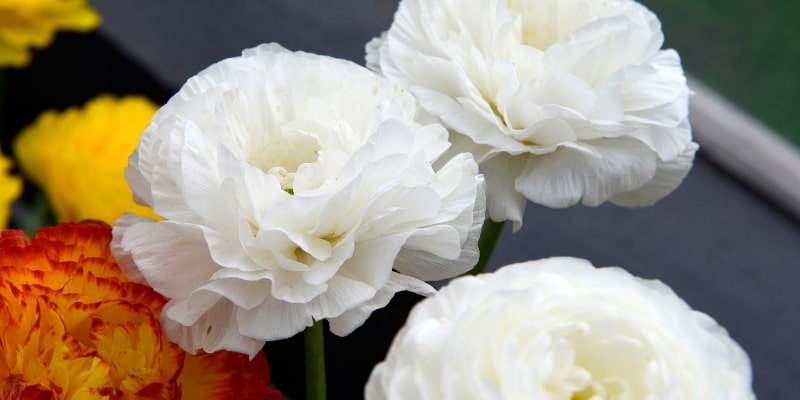
Scientific Name: Ranunculus asiaticus
Plant Type: Perennial or annual herbs
Plant Size: 8 to 18 in. tall and 6 to 12 inches Broad
Sun Exposure: Full Sun
Geographic Origin: Mediterranean and southwest Asia
Plant Zone: 8 to 10
Florists love Ranunculus plants for their lengthy vase lives and robust, spiralling petals. They are commonly used in bouquets and flower arrangements since they keep for a long time when removed from the stem. If planted in well-drained soil, some varieties of ranunculus plants, which are normally annuals, can be induced to bloom for a second year.
3. White Bouvardia
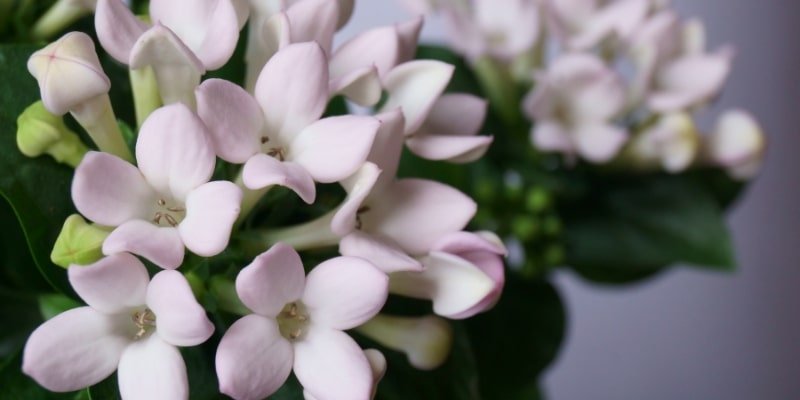
Scientific Name: Bouvardia
Plant Type: Shrubs
Plant Size: 2-5 ft
Sun Exposure: Full Sun
Geographic Origin: Mexico, Central and South America
Plant Zone: 9 to 11
This plant is immediately recognized as décor for weddings and other special occasions because of its broad, dark-green leaves and small, star-shaped blooms. They are great houseplants and do well in warm, temperate climates.
4. Gardenia

Scientific Name: Gardenia Jasminoides
Plant Type: Evergreen Shrub
Plant Size: 3-8 ft
Sun Exposure: Full Sun, Partial Sun
Geographic Origin: Asia
Plant Zone: 7 to 10
Shrub flowers called gardenias have enormous blooms that measure four to five inches in diameter. They prefer clay, loam, and sandy soil, and they bloom from late spring to early summer.
Compared to other plants, they require a great deal more care since they are more vulnerable to mildew, leaf spots, anthracnose, mould, scales, aphids, mealy bugs, and spider mites.
Sandy, loam, and clay soils are preferred by gardenias. In addition, the soil needs to be well-drained and wet. They enjoy the early light and the afternoon shadow, and they require an abundance of sunlight. Although gardenias can grow up to twelve feet tall, they will gladly stay four to six feet tall in warmer regions and with proper trimming. Additionally, they resist deer.
5. Moonflower

Scientific Name: Ipomoea Alba
Plant Type: Perennial vine
Plant Size: 10–15 ft. tall
Sun Exposure: Full Sun
Geographic Origin: Tropical America
Plant Zone: 3 to 9
The late afternoon blooms of trumpet-shaped flowers on moonflower vines leave a light scent that permeates the area around them. The vines will gladly encircle everything that comes into contact with them. Soon you’ll have a lovely, fragrant vine to add to your yard if you gently guide the vines through a trellis.
6. Hydrangea

Scientific Name: Hydrangea Aborescens
Plant Type: Deciduous Shrub
Plant Size: 3-5 ft tall
Sun Exposure: Full Morning Sun, Afternoon Shade
Geographic Origin: Asia, Americas
Plant Zone: 3 to 9
The hundreds of small flowers that hydrangeas produce grow in tight clusters. These bushy bundles have a height and width of approximately three to five feet. The flower clusters measure around six inches in diameter.
This plant produces thousands of flowers in addition to huge, vibrant foliage. It likes both full and partial sun, and it blooms all summer long and into autumn. As long as the soil is moist and well-drained, hydrangeas can grow in sandy, loam, and clay soil.
Hydrangeas can be propagated by seeds or cuttings, and they should be pruned in late winter or early spring. Bud blight, bacterial wilt, rust, mould, mildew, leaf spots, aphids, mites, scale, and nematodes are among the problems they frequently face.
7. Gerbera Daisy

Scientific Name: Gerbera jamesonii
Plant Type: Herbaceous perennial
Plant Size: 6 to 18 inches
Sun Exposure: Full Sun
Geographic Origin: South Africa, Tropical America
Plant Zone: 8 to 11
Compared to ordinary daisies, gerbera daisies are substantially larger perennial plants with stunning, semi-evergreen blossoms. Gerbera daisy blossoms typically have two-inch-wide petals and bloom from April through autumn.
8. Magnolia Flower

Scientific Name: Magnolia Denudata
Plant Type: Shrub, Tree
Plant Size: 30-40 ft
Sun Exposure: Full Sun, Partial Sun
Geographic Origin: China
Plant Zone: 5 to 9
Magnolia trees are known for their exquisite beauty. This plant, which flowers when the branches are still barren in late winter or early spring, revitalizes any garden. The tree can grow to be thirty to forty feet high and spread, despite the exquisite three-inch blossoms.
This white-flowering tree thrives on sandy, clay, and loam soils that are well-drained yet still moist. Butterflies and birds are also drawn to it. Magnolias don’t need much maintenance, and they love the sun. They should be protected from strong winds and have any dead flowers removed in the summer.
9. Lily of the Valley
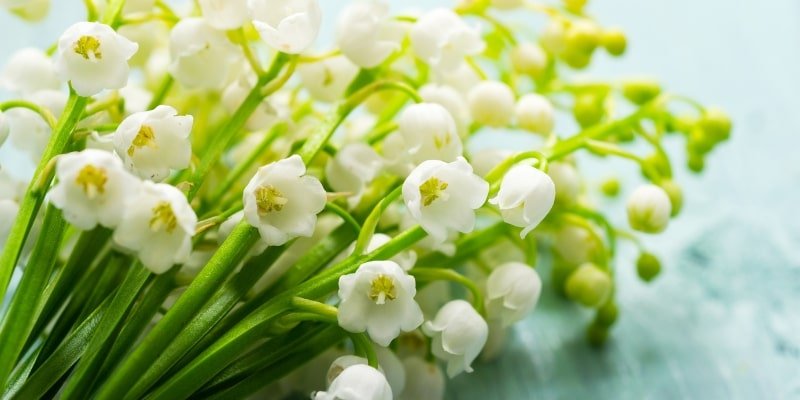
Scientific Name: Convallaria majalis
Plant Type: Fragrant perennial herb
Plant Size: 6–12 in. tall
Sun Exposure: Partial sun to full shade
Geographic Origin: Eurasia and eastern North America
Plant Zone: 3 to 9
Any garden would benefit from the lovely addition of lilies in the valley. It has numerous tiny white flowers that resemble bells and only gets six to twelve inches tall. In addition to being little maintenance, the blooms smell nice.
Clay and loam soils with sufficient drainage and moderate moisture content are preferred by this plant. However, they may tolerate clay-rich, dry soil. They also gain from an annual treatment of composted organic matter.
10. White Lavender

Scientific Name: Lavandula angustifolia
Plant Type: Flowering Plants
Plant Size: 60-80cm tall
Sun Exposure: Full Sun
Geographic Origin: Southern Portugal and southwest Spain
Plant Zone: 5 to 9
The sight of white lavender is uncommon yet magnificent. The majority of white lavender cultivars belong to one of the five fundamental types of lavender that gardener’s plant.
Purple and white lavenders are similar in appearance and potent aroma. The stems can grow up to twenty or twenty-four inches tall, and they cluster together into twenty-four to thirty-inch-wide groups. Midsummer until late April is when lavender blossoms.
11. Peony

Scientific Name: Paeonia Lactiflora
Plant Type: Herbaceous perennial
Plant Size: 2-3 ft tall
Sun Exposure: Full Sun
Geographic Origin: Europe and Western North America
Plant Zone: 3 to 8
The peony blooms from late spring to early summer, with the possibility of white blooms. They require any kind of moist, well-drained soil and like sunshine.
Peonies look great indoors and in containers in the garden. They will attract butterflies and are resistant to deer and rabbits. Peonies can reach heights of thirty inches and widths of twenty-four to thirty-six inches. The blossoms are two to three inches in diameter.
Peonies are low-maintenance plants that rarely suffer from insect or disease problems. They are not edible and have a lengthy lifespan.
12. Periwinkle
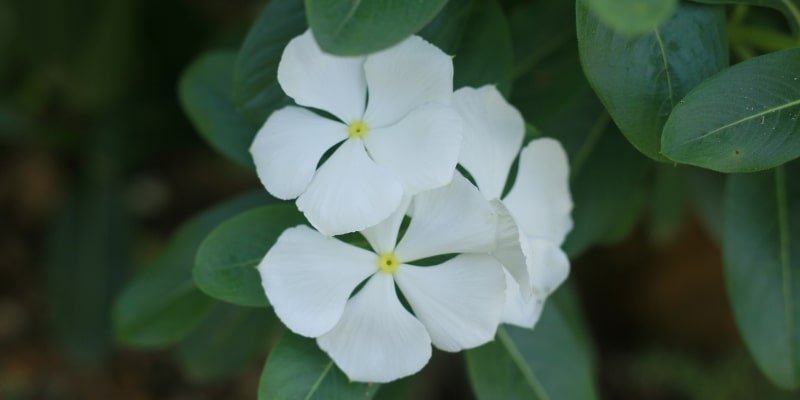
Scientific Name: Catharanthus Roseus
Plant Type: Herbaceous perennial
Plant Size: 6-18 in. tall
Sun Exposure: Full Sun, Partial Shade
Geographic Origin: Madagascar
Plant Zone: 11 to 12
Perennial periwinkles are small, low-lying plants that grow to a maximum height of four to six inches and a maximum spread of twenty-four to thirty-six inches. Although it can withstand dry and even droughty circumstances, this plant prefers any amount of light or shade and moist soil.
Periwinkles require little outside maintenance and don’t often suffer from pest or disease issues. This flower has good evergreen ground coverage and blooms in the spring, summer, and autumn. It can thrive in rocky environments and is resistant to rabbits and deer. This butterfly-attracting plant is an invasive species in some places.
13. Sweet Alyssum
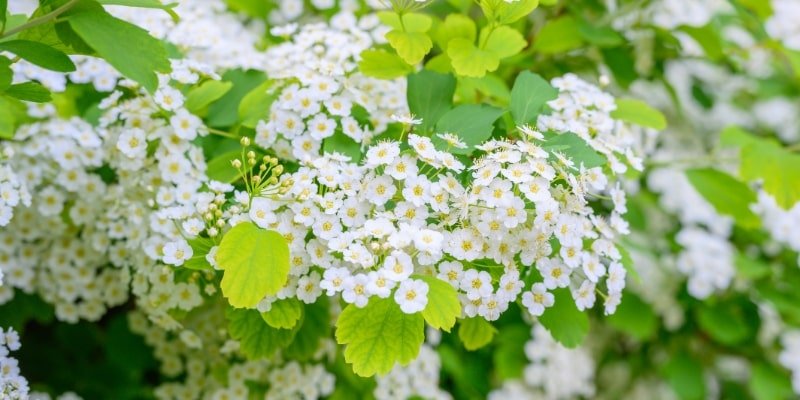
Scientific Name: Lobularia Maritima
Plant Type: Annual
Plant Size: 2–12 in tall
Sun Exposure: Full Sun, Partial Shade
Geographic Origin: Southern Europe
Plant Zone: 2 to 11
Strong and resilient, sweet alyssum can withstand dry soil, harsh climates, and periods of drought. Exuberant blossoms bloom from late spring until the first frosts of winter.
Although it can tolerate a lot, calcareous, loam, or sandy soil with good drainage are the optimal growing conditions for this plant. It prefers both full and partial sun. It’s deer-resistant and will draw butterflies. This plant is invasive in certain places. It grows better with regular fertilization and shearing.
14. Wisteria
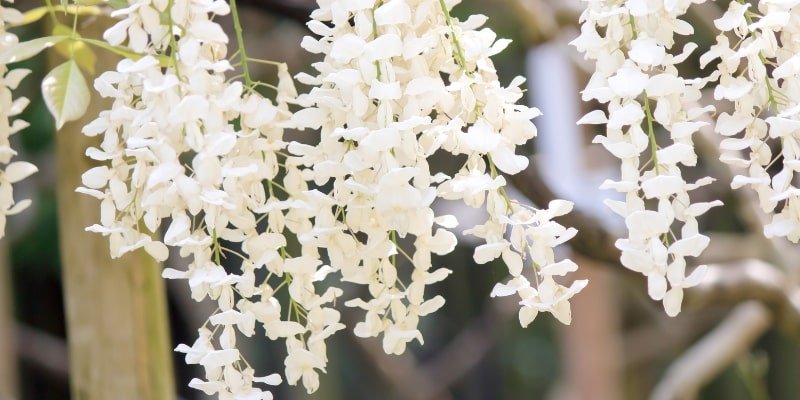
Scientific Name: Wisteria
Plant Type: Perennial
Plant Size: 10-30 feet
Sun Exposure: Full Sun, Partial Shade
Geographic Origin: Asia and North America
Plant Zone: 5 to 9
Wisteria has an absolutely enchanted appearance. This tree, sometimes known as lavender lace, has silky, long tendrils of blossoms that dangle like willows. The tree spreads equally in width and can reach heights of ten to thirty feet.
Wisteria grows in any type of wet, well-drained soil and prefers both full and partial sun. It grows well in dryness and among deer because it is aromatic and appealing to butterflies. This plant is not edible and is invasive in several areas of North America. It’s not fond of transplanting either.
15. Fan Flower
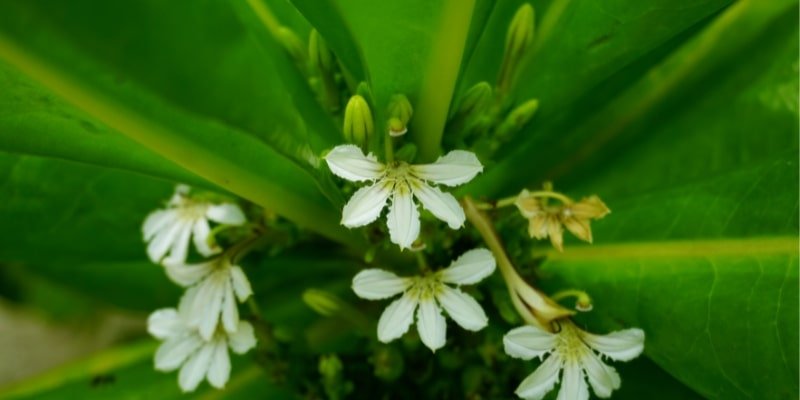
Scientific Name: Scaevola taccada
Plant Type: Evergreen perennial/shrub
Plant Size: 9–18 in. tall, 1–2 ft. wide
Sun Exposure: Full, Partial
Geographic Origin: Australia
Plant Zone: 10 to 11
These beautiful white annual blooms are low-maintenance and look great every year. Although they are native to southern Australia, their resistance to summer heat has made them popular in gardens all over the world. Because of their propensity to draw pollinators and their resilience to neglect and adverse weather, they make a great addition to any garden.
16. White City Spanish Bluebells
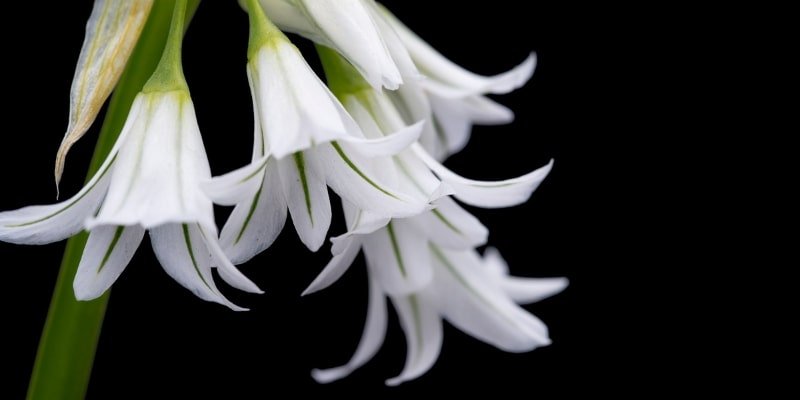
Scientific Name: Hyacinthoides Hispanica
Plant Type: Bulbous Perennials
Plant Size: 12-15 in
Sun Exposure: Full Sun, Partial Sun
Geographic Origin: Spain, Portugal and northwest Africa
Plant Zone: 3 to 8
White City Spanish bluebells is lovely flowers that have a graceful, lengthy appearance. With their long leaves and slender stems topped with little groupings of white flowers, they are between twelve and fifteen inches tall.
Any kind of soil will do for this plant as long as it is well-drained, wet, and gets either full or partial sun. The flowers are resistant to drought, dry soil, deer, and rabbits, and they bloom in the middle to late spring. This plant may be grown indoors, in pots, or in gardens. Both clipped and arranged, they look gorgeous.
17. Iris

Scientific Name: Iris sibirica
Plant Type: Perennial
Plant Size: 8 to 40 inches
Sun Exposure: Direct Sunlight
Geographic Origin: Europe and Asia
Plant Zone: 5 to 9
Despite its name, which is derived from the Greek word for a rainbow, most wild irises are white, but this genus of flowering plant comes in a broad array of brilliant hues. Iris requires a lot of room to flourish because of their long stalks and constant competition with other plants for sunlight.
18. Tulip
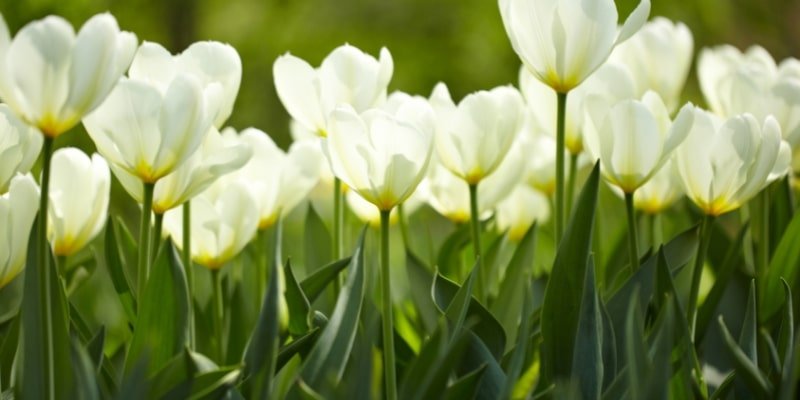
Scientific Name: Tulipa
Plant Type: Perennials
Plant Size: 4-28 in high
Sun Exposure: Full Sun
Geographic Origin: Southern Europe to Central Asia
Plant Zone: 3 to 8
Tulips bloom in the middle to late spring and love bright, direct sunlight. They have very straight single stems and are around 10 inches tall.
Tulips prefer calcareous, loam, and sandy soils and need minimal maintenance from the outside. They grow well in gardens, containers, and indoor spaces, making them among the best flowers for arrangements. So the bulbs in the autumn. Dry, temperate summers are preferred by tulips, as are mild winters.
19. Calla Lily
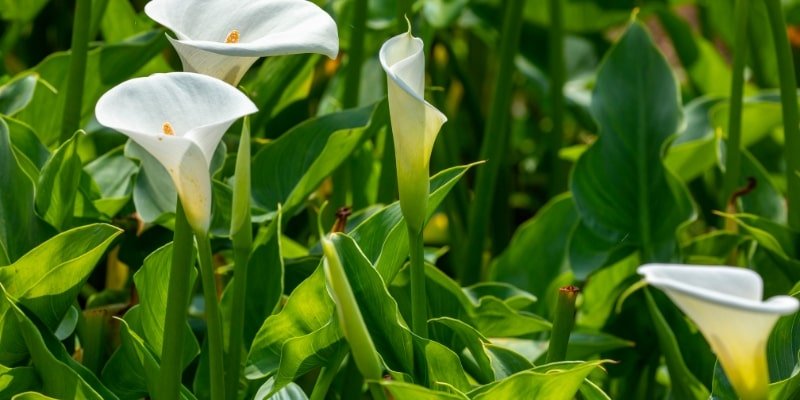
Scientific Name: Scaevola taccada
Plant Type: Flowering perennial
Plant Size: 1 and 2 feet tall
Sun Exposure: Full sun or partial shade
Geographic Origin: southern Africa in Lesotho, South Africa, and Eswatini
Plant Zone: 8 to 10
The calla lily is a native of southern Africa. It may be easily identified by its ear-like form and colourful, projecting pistil. Though most people refer to the calla lily as a lily, in reality it is a Zantedeschia, a different sort of flower. An error occurred during the plant’s initial naming process, which led to this false assumption.
There are many different colours of calla lilies to choose from, though the white variety is the most common. Water-rich, warm, and humid conditions are ideal for calla lilies to flourish. They thrive in areas with more heat and shade.
20. Petunia
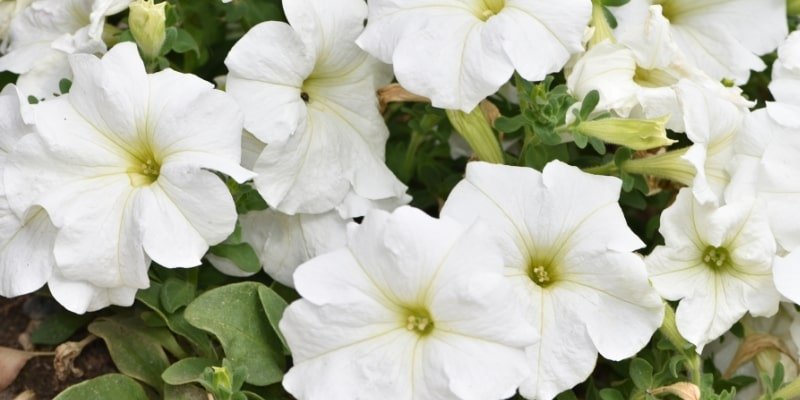
Scientific Name: Petunia
Plant Type: Nightshade
Plant Size: 6 inches to 18 inches
Sun Exposure: Full Sun
Geographic Origin: South America
Plant Zone: 9 to 11
Petunia plants come in a range of vivid colours and are considered annual perennials. To acquire the desired sorts of white flowers, plant blanket double white or supertunia white varieties. From the start of spring until the first frost, they will consistently bloom if they receive adequate direct sunlight.
These gorgeous flowers need very little care; however, removing dead blooms and giving them the occasional trim will improve their bloom.
21. Virginia Sweetspire
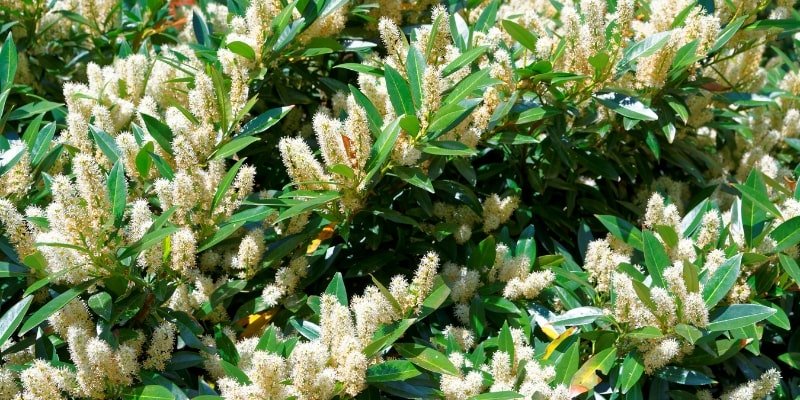
Scientific Name: Itea Virginica
Plant Type: Deciduous Shrub
Plant Size: 8ft
Sun Exposure: Full Sun
Geographic Origin: Eastern United States
Plant Zone: 4 to 6
A distinctive plant, the Virginia sweetspire bears long tendrils of white flowers. It is three to ten feet tall and equally wide. Virginia sweetspire has a pleasant scent and prefers any amount of shade or sun. Moreover, it is semi-evergreen.
This plant thrives in soil types ranging from clay to loam, and insect and disease issues are infrequent. After flowering, it should be clipped; it can be kept as a bush or styled like a hedge. It blooms from the middle of spring to autumn.
22. Phlox
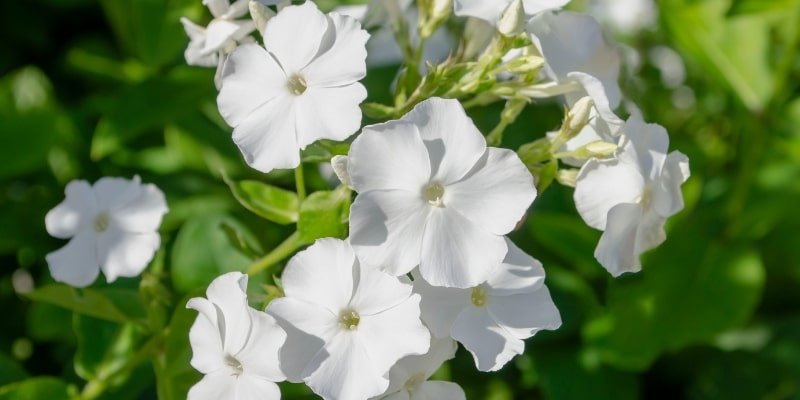
Scientific Name: Phlox
Plant Type: Herbaceous perennial
Plant Size: 2-4 ft tall
Sun Exposure: Full Sun
Geographic Origin: American
Plant Zone: 4 to 8
Phlox is a summer flower that enjoys some shade and sunlight. It resists deer and grows well in clay, loam, and calcareous soils.
Phlox plants can grow to a height of three to four feet, and their flowers are produced in thick clusters. This plant attracts butterflies and hummingbirds and prefers chilly air. It also has exceptional resistance against mildew and mould. Both in groupings and as solitary plants, they look good. Phlox has a pleasant scent and self-seeds. It gives any garden life.
23. White Rose
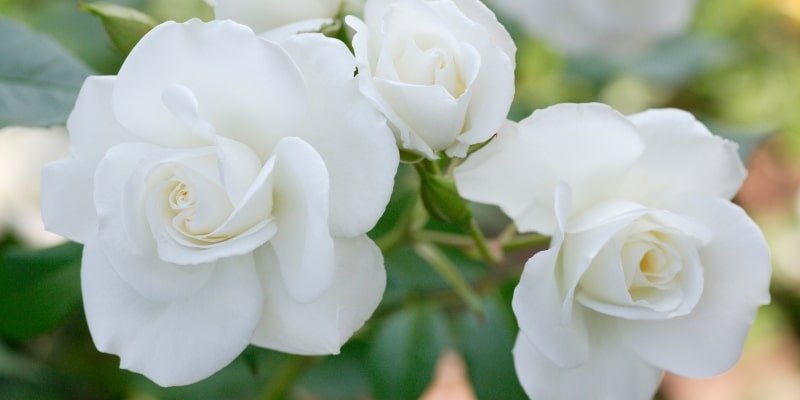
Scientific Name: Rosa X Alba
Plant Type: Deciduous shrub
Plant Size: 6-9 ft
Sun Exposure: Full Sun
Geographic Origin: Europe
Plant Zone: 3 to 8
Among the most beautiful roses is the white one. Its flowers are six or seven inches across, and it stands six to eight feet tall. These perennial white flowers have a strong scent and bloom from late spring to early summer.
White roses prefer clay, loam, and sandy soils, with the occasional addition of compost or fertilizer. They also tolerate shade. Cuttings are used for propagation, and they have a beautiful appearance.
24. Alliums
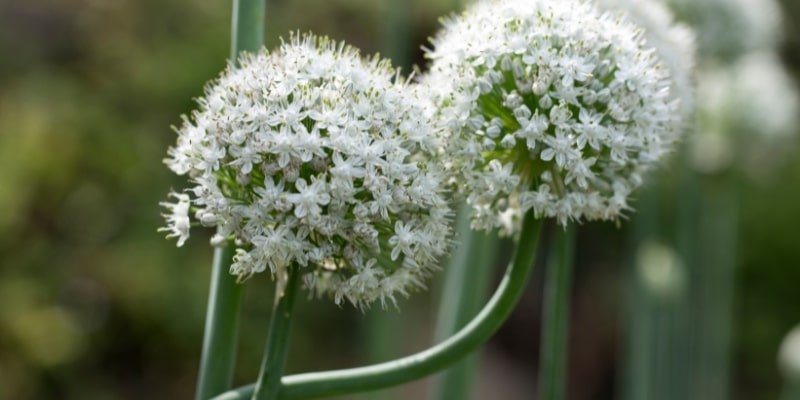
Scientific Name: Allium
Plant Type: Perennial
Plant Size: 6 inches to 3 feet
Sun Exposure: Full Sun
Geographic Origin: Central Asia
Plant Zone: 3 to 8
Plants that belong to the onion and garlic families include white allium. Known as the “White Giant,” this plant may reach a height of four feet and yield globes that are six to eight inches in diameter. From late spring to early summer, these perennial flowers thrive in full light. For maximum impact, plant in groups of ten to fifteen in the autumn.
Allium can tolerate droughts and conditions with lots of deer and rabbits. It grows well in chalky, sandy, and clay-filled soils. They draw butterflies to them.
25. Snowdrop
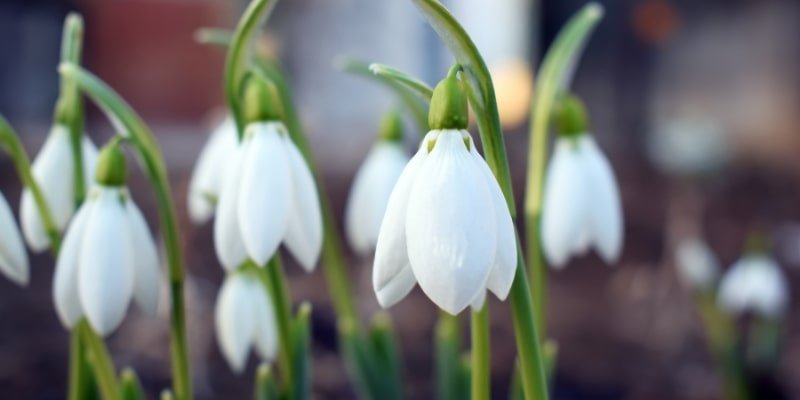
Scientific Name: Galanthus nivalis
Plant Type: Flowering plants
Plant Size: 4-10 tall
Sun Exposure: Full sun to part shade
Geographic Origin: Europe
Plant Zone: 3 to 7
Galanthus sometimes referred to as “snowdrop,” gets its name from the eye-catching, bulbous, white blossoms that, when fully bloomed, droop. Snowdrops are quite easy to produce since they are harder than their name suggests. Since they won’t grow very tall, set them up where they can be seen, at the side of the bed.
26. Arabian Jasmine

Scientific Name: Jasminum Sambac
Plant Type: Perennial Shrub
Plant Size: 1.6-9.8 ft
Sun Exposure: Full Sun
Geographic Origin: Bhutan and India
Plant Zone: 8 to 11
The gorgeous Arabian jasmine plant has a strong, alluring scent. It’s a scrambling evergreen that can grow six to ten feet tall and wide, and it can interweave with support. The numerous white blooms, which can last the entire summer or longer in warmer climates, are grouped in clusters of three to twelve. With age, their blossoms also turn pink.
Arabian jasmine prefers loam soils and both full and partial sun. It needs proper drainage but takes little upkeep. It may be shaped and pruned, and pests are rare.
27. Daffodil
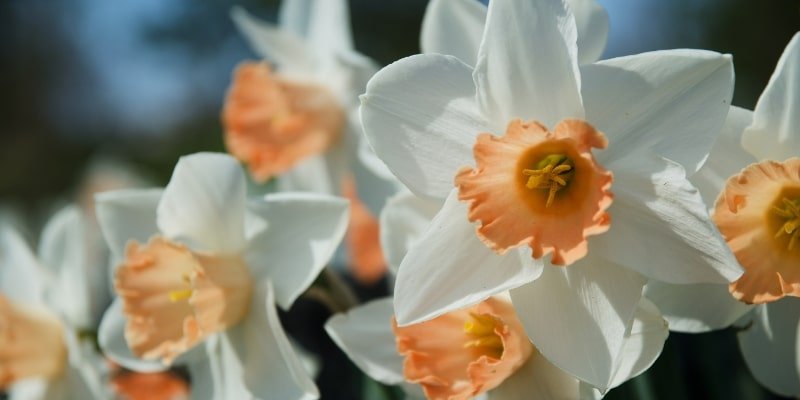
Scientific Name: Narcissus
Plant Type: Shrub, Perennial
Plant Size: 6–30 in. tall
Sun Exposure: Full sun but will tolerate light shade
Geographic Origin: southern Europe and North Africa
Plant Zone: 3 to 8
Daffodils are sun-loving flowers with six petals encircling a trumpet-shaped central crown. When planted in the autumn, daffodil bulbs will bloom beautifully in the early spring and represent optimism, resilience, and rebirth.
Their Latin name, Narcissus, is derived from the story of an old Greek hunter who developed feelings for his own reflection. Luckily, these gorgeous blooms take minimal upkeep and are resistant to rabbits and deer.
28. Nemesia
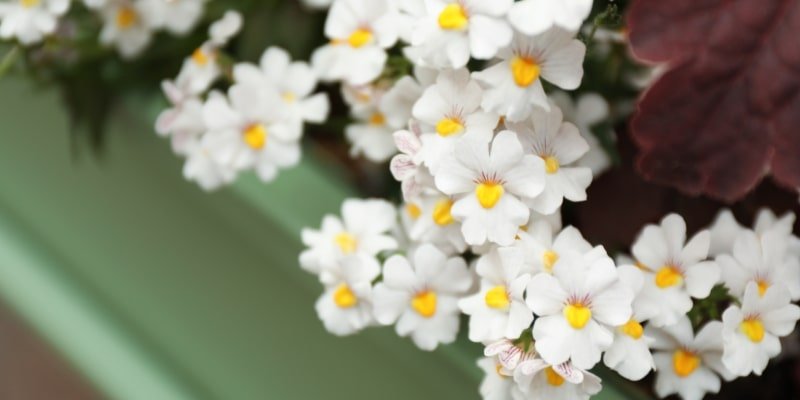
Scientific Name: Nemesia
Plant Type: Tender perennials, annuals and sub-shrubs
Plant Size: 12 to 24 inches
Sun Exposure: Full Sunlight
Geographic Origin: South Africa
Plant Zone: 2 to 10
Nemesia is a bushy annual plant that seldom gets taller than half a meter and is covered in tiny white blossoms in abundance. It is a perfect addition to gardens with taller plants that offer dappled shade because it grows well in partial sunshine.
This plant requires minimal maintenance and has aromatic blossoms, making it a great choice for novice gardeners. However, keep in mind that it needs fertilization after pruning and that it flowers less in warm areas.
29. Camellia
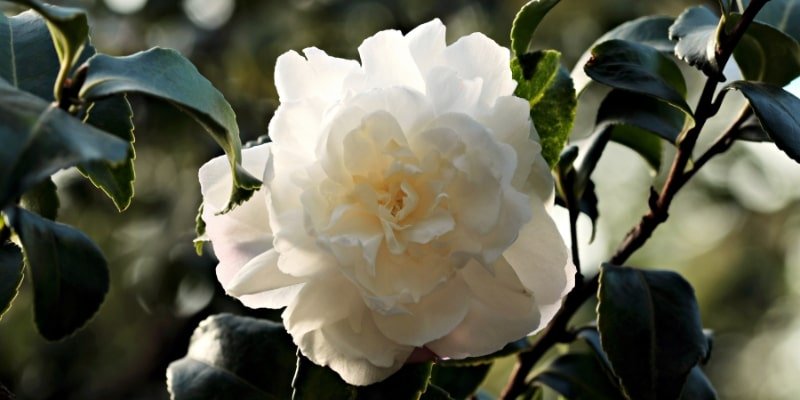
Scientific Name: Camellia Japonica
Plant Type: Shrub, Evergreen
Plant Size: 6-14 feet
Sun Exposure: Full Sun
Geographic Origin: Eastern and Southern Asia, from the Himalayas east to Japan and Indonesia
Plant Zone: 7 to 9
Shrubs with a modest growth rate that like cooler climates are called camellias. Measuring only six to eight inches in height, they spread equally widely. The flowers have hundreds of graceful petals and measure three to four inches in width.
Camellias grow well in sandy, clay, and loam soils and don’t require much care. Plant them in places that are protected from strong, cold winds and intense sunlight. Avert basic soils and the morning sun. Aphids, scale insects, and vine weevils can be drawn to camellias, which is why they require pruning following flowering.
30. Amaryllis
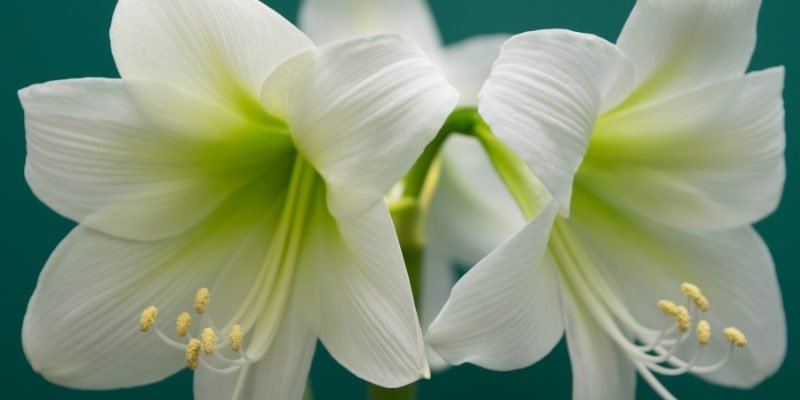
Scientific Name: Amaryllis
Plant Type: Bulbous plant
Plant Size: 5–10 cm (2.0–3.9 in)
Sun Exposure: 6 hours of sun daily
Geographic Origin: South American
Plant Zone: 8-10
The Alfresco kind of amaryllis is a stunning, full plant with two to three stems per bulb and five to eight flowers per stem. Usually reaching a height of twelve to eighteen inches, the plant bears blossoms for several weeks or months.
If given the right conditions, amaryllis are hardy perennial blooms that can survive for up to 75 years. They require little upkeep and grow well in clay, sandy, and loam soils.
31. Dendrobium Orchid

Scientific Name: Dendrobium
Plant Type: Perennial
Plant Size: 6-48 in. tall
Sun Exposure: Lots of light, but not direct sun
Geographic Origin: Tropical and subtropical Asia, many Pacific islands, and Australia
Plant Zone: 9-12
When grown under ideal conditions, this type of orchid is rather easy to grow. These are exquisite decorative houseplants with delicate, white blossoms. Little pots and lots of sunlight are ideal for orchid growth.
32. Carnation
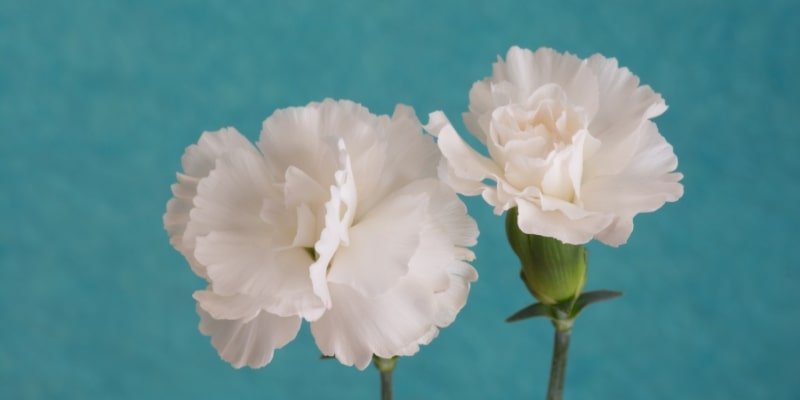
Scientific Name: Dianthus caryophyllus
Plant Type: Herbaceous plant
Plant Size: 6-24 in. tall, 10-14 in. wide
Sun Exposure: Full Sun but Partial Shade
Geographic Origin: Eurasia
Plant Zone: 7-19
One of the various hues and variations of carnations is white. They grow to a maximum height of thirty inches and are perennials. Carnations can be multiplied by cuttings and blooming in the summer. This plant needs plenty of sunshine, damp soil, and infrequent irrigation.
Carnations need to be trimmed after they bloom. When these hardy plants bloom, they release a fragrant, spicy aroma. Bees and hummingbirds are attracted to their unique scent.
33. Angelonia
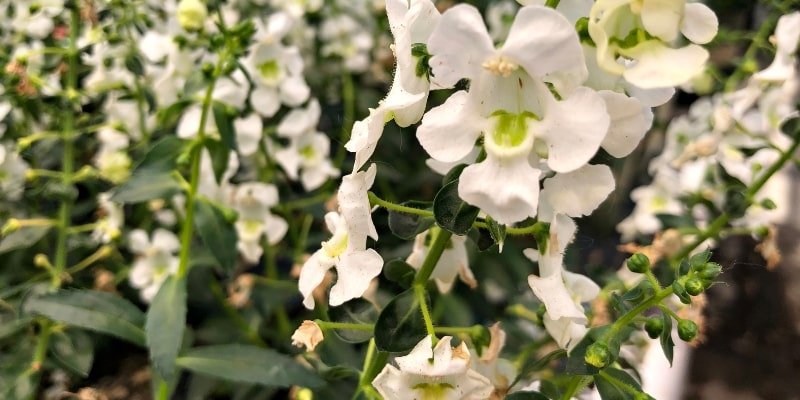
Scientific Name: Angelonia
Plant Type: Annual, Perennial
Plant Size: Height-1 to 3 feet, Width -1 to 2 feet
Sun Exposure: Full Sun
Geographic Origin: Mexico and the West Indies
Plant Zone: 9-11
Angelonia, sometimes called angel face, is a delicate perennial that needs very little care and very little moisture. It prefers full sun and grows well in normal chalky, clay, or sandy soil.
Angelonia grows to a maximum height of forty to thirty inches and a maximum width of eighteen to twelve inches. It is a great white-blooming plant for novices because it can be produced from cuttings, is self-cleaning, and rarely attracts disease or pests.
34. Foxglove
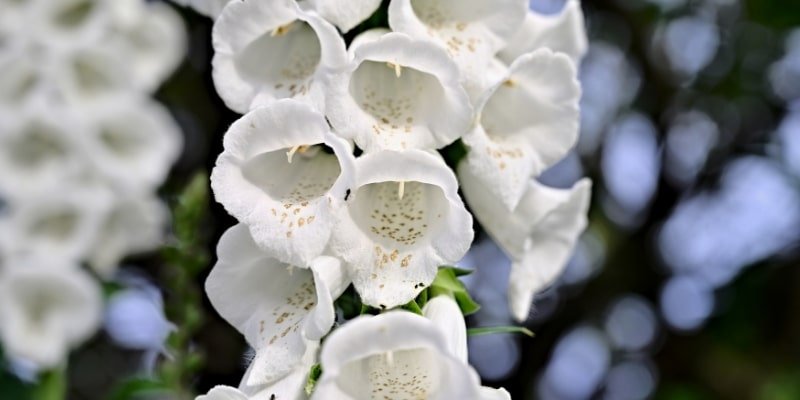
Scientific Name: Digitalis purpurea
Plant Type: Herbaceous perennial
Plant Size: 3 to 4 feet tall
Sun Exposure: Full Sun to Partial Shade
Geographic Origin: Western Europe and North Africa
Plant Zone: 4-9
The tall, bold, leafy stems of foxglove shrubs bear drooping bell-shaped purple or white blooms. In addition to being low-maintenance and resistant to deer and rabbits, this flowering shrub brings pollinators into your garden, including hummingbirds, butterflies, and other birds. This sun-loving plant thrives in light shade during the warmer months.
35. Canada Anemone
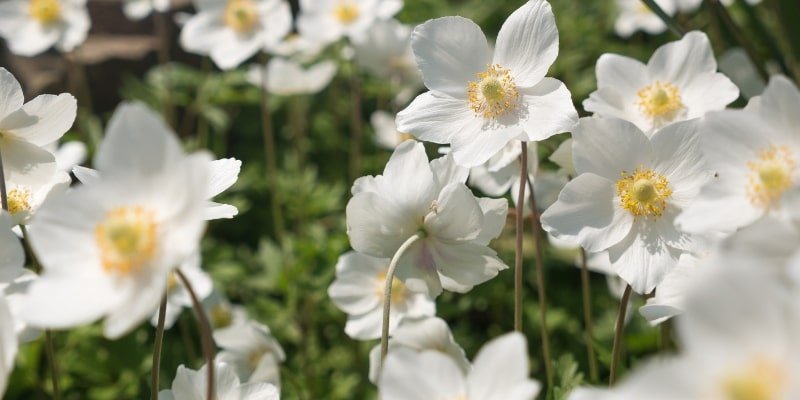
Scientific Name: Anemone Canadensis
Plant Type: Herbaceous Perennial
Plant Size: 12-24 in. tall
Sun Exposure: Partial Sun, Shade
Geographic Origin: North America
Plant Zone: 3 to 8
Canada Hardy perennials like anemones thrive well in sandy, chalky, clay, or loam soil. It needs a considerable quantity of water, but not much maintenance.
The typical dimensions of a Canada anemone are twelve to twenty-four inches in height and twenty-four to thirty inches in width. It prefers moist but well-drained soil and places that are partly sunny or shaded.
This plant, sometimes known as the meadow anemone, does best growing near streams, ponds, and meadows. Although it doesn’t frequently attract illness or pests, it can develop mildew and attract slugs, flea beetles, and caterpillars.
36. Floristan White Liatris
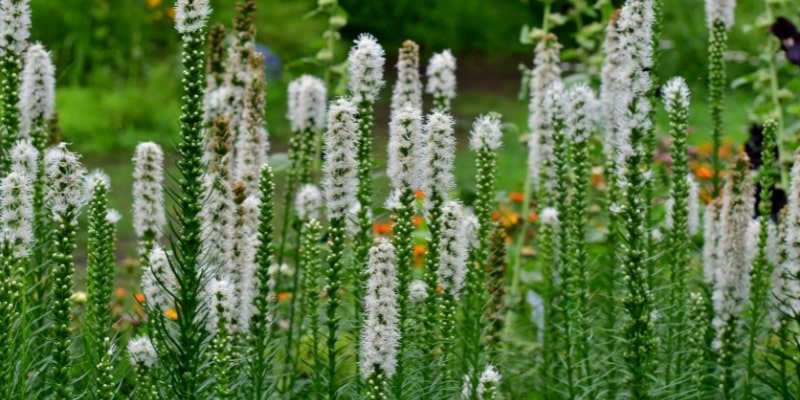
Scientific Name: Liatris Spicata
Plant Type: Herbaceous Perennial Flowering Plant
Plant Size: 2-4 ft tall
Sun Exposure: Full Sun
Geographic Origin: Eastern North America
Plant Zone: 3 to 9
A unique perennial that resembles grass and produces long stalks of white flowers is called Floristan White Liatris.
Typically growing to a height of three to four feet, the plant blooms throughout the summer for four weeks from the bottom up. This plant is well known for drawing hummingbirds, bees, butterflies, and other birds.
Birds might find food in the dry seed head during the winter. It thrives under full sun exposure and can withstand drought and wildlife. This plant grows in any type of soil and requires little maintenance. Floristan White Liatris thrives well in moist gardens, meadows, and prairies and is almost disease- and pest-free. It also creates beautiful bouquets when dried.
37. Baby’s Breath
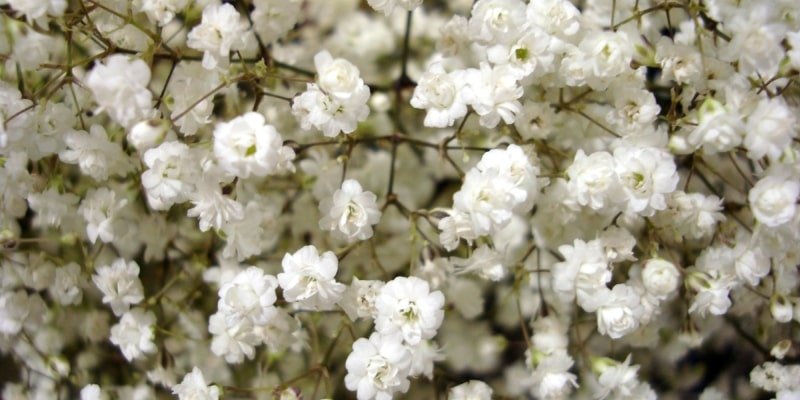
Scientific Name: Gypsophila
Plant Type: Annual and perennial
Plant Size: 2–3 ft. tall, 2–3 ft. wide
Sun Exposure: Direct Sunlight
Geographic Origin: Eurasia
Plant Zone: 3 to 9
Gypsophila, or baby’s breath, is a popular flower used in floral arrangements by florists. Thin stems create the tiny, delicate, white blossoms. In bouquets and interior flower arrangements, both fresh and dried flowers are employed as ornaments.
38. Gooseneck Loosestrife
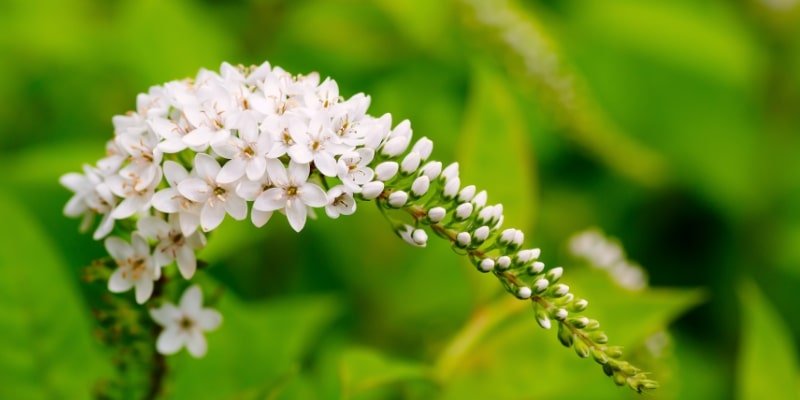
Scientific Name: Lysimachia clethroides
Plant Type: Perennials
Plant Size: 2-3 ft. tall, 2-4 ft. wide
Sun Exposure: Full Sun, Partial Sun
Geographic Origin: East Asia
Plant Zone: 3 to 8/9
A rare perennial, gooseneck loosestrife, produces curving flower stalks resembling goosenecks. The plant itself grows to a height of two to three feet, and the so-called necks are roughly twelve to eighteen inches long.
Spreading two to four feet, gooseneck loosestrife likes both full and partial sun. Although it can thrive in any soil and requires little external care, it favours marshes, riverbanks, and bog gardens. It is resistant to deer, rabbits, and moist soil, and it hardly ever has pests or illnesses. This plant blooms from June to autumn. It must be trimmed once it has flowered.
39. Mock Orange
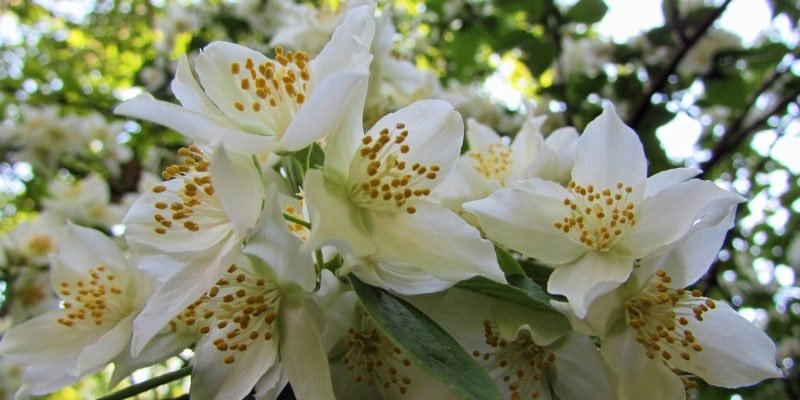
Scientific Name: Philadelphus
Plant Type: Deciduous Shrubs
Plant Size: 10-12 ft. tall
Sun Exposure: Full Sun, Partial Sun
Geographic Origin: Northern Italy, Austria
Plant Zone: 4 to 7
The little, round, deciduous mock orange shrub is well-known for its strong aroma. The shrub loves both full and partial sun, and it blooms from late spring to early summer. This plant can withstand clay soils, rabbits, and any kind of fairly moist soil.
The fake orange can reach heights of ten to twelve feet and widths of the same. The blossoms have a diameter of just one inch. Pests and diseases rarely affect mock oranges, although they might cause issues with mildew, canker, and leaf spot.
40. Astilbe
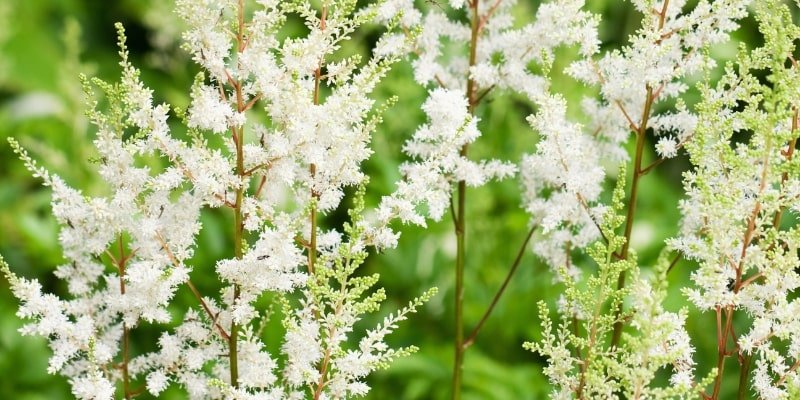
Scientific Name: Astilbe
Plant Type: Perennial
Plant Size: 6-24 in tall
Sun Exposure: Partial Shade to Full Shade
Geographic Origin: North America, Asia
Plant Zone: 3 to 8
Fantastical blooms that grow in enormous clusters are called astilebes. They need lots of water and adequate drainage, prefers loam soil, and can tolerate deer, rabbits, and moist soil in addition to doing well in any amount of sun.
They flower for a few months, beginning in the early summer. Perennial asters can reach up to twenty-eight inches in height and thrive in shade. They can thus provide thick, dense foliage throughout the entire season. The flower stalks give interest all winter, fading into a rich caramel as they die off.
41. Clematis
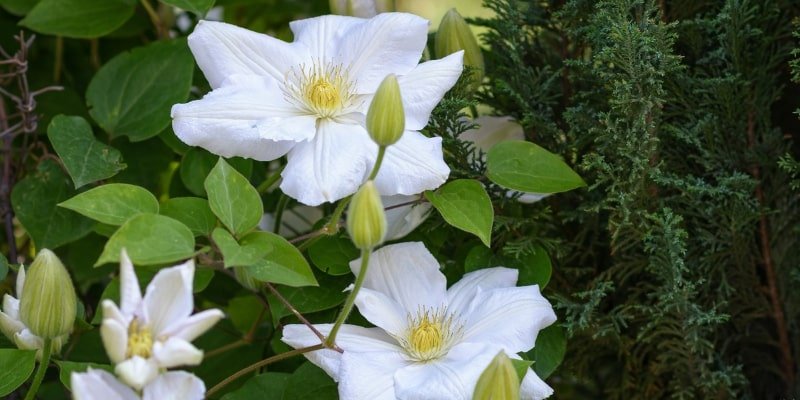
Scientific Name: Astilbe
Plant Type: Perennial Vine
Plant Size: 20 to 30 feet
Sun Exposure: Full Sun to Partial Shade
Geographic Origin: Japan and China
Plant Zone: 4 to 9
Beautiful climbing plants, clematises, can reach heights of eight to ten feet and produce flowers that are typically five to six inches across. As long as there is enough water, this plant may grow in soil that is sandy, chalky, clay, or loam. It also requires very little upkeep.
Depending on the climate, clematises can bloom from late spring to autumn and provide an abundance of vibrant flowers. Clematis grows easily and prefers situations that are somewhat shaded. There’s a particularly beautiful white strain of the asagasumi kind.
42. Hellebore
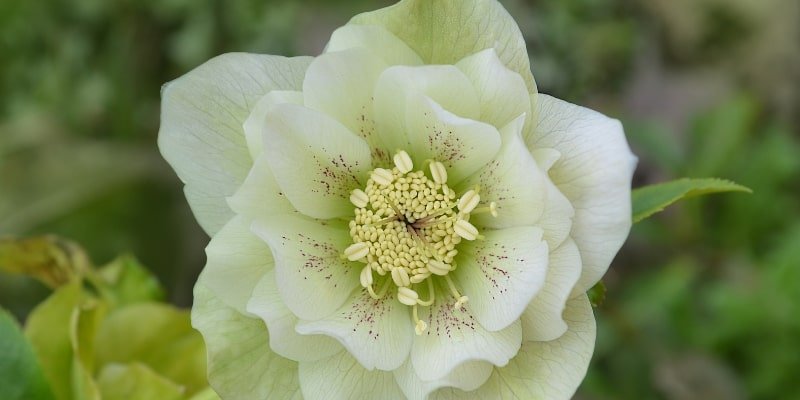
Scientific Name: Helleborus
Plant Type: Herbaceous or evergreen perennial
Plant Size: 9 to 18 inches tall and 12 to 24 inches wide
Sun Exposure: Full Sun to Partial Shade
Geographic Origin: Europe and Asia
Plant Zone: 6 to 9
Hardy plants like hellebores stay evergreen everywhere; they don’t get really cold winters. In order to fully appreciate the white blossoms, they are often planted on hills or slopes. They are perennials that go well with snowdrops and daffodils, which were also discussed in this piece.
43. Candytuft
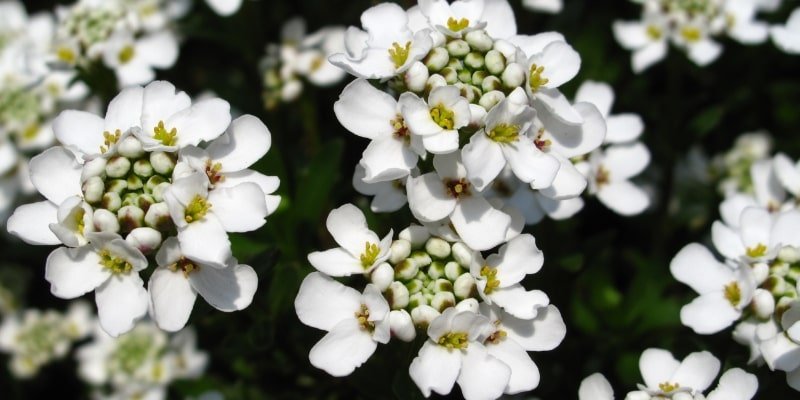
Scientific Name: Iberis Sempervirens
Plant Type: Perennial
Plant Size: 12–18 in. tall, 12-16 in. wide
Sun Exposure: Full, Partial Sun
Geographic Origin: Northwest Africa
Plant Zone: 3 to 9
The sturdy, bushy Candytuft plant is between six and twelve inches tall and twelve and eighteen inches broad. It is composed of dark green, evergreen leaves and clusters of tiny white flowers.
Candytuft has pretty normal watering and maintenance requirements, and it blooms from spring until early summer. It is a perennial that enjoys strong sunlight. This plant also does well in calcareous, sandy, and well-drained soils that are damp but not soggy. It can withstand drought, deer, and rabbits. After flowering is over, maintain the plant by cutting back one-third of its length.
44. Heliotrope
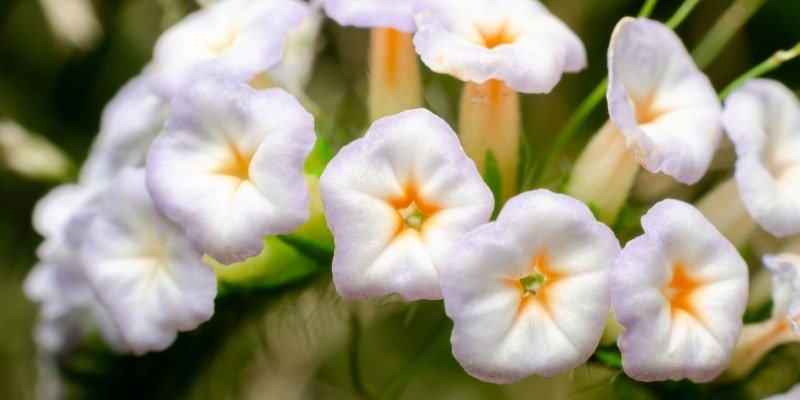
Scientific Name: Heliotropium
Plant Type: Annual
Plant Size: 1-3 ft
Sun Exposure: Full Sun
Geographic Origin: Bolivia, Colombia, and Peru
Plant Zone: 9 to 10
The perennial heliotrope plant blooms in the spring, summer, and autumn and prefers full sun exposure. It is attractive to butterflies since it is twelve to eighteen inches tall and produces a lot of flowers when its stems unfold.
If consumed, the heliotrope is poisonous. It spreads by spreading its roots widely and producing seeds. This plant can become out of control because it spreads quickly, requires little to no care, and requires very little water, especially in agricultural settings. It also doesn’t have a lot of pest or disease issues. While it can tolerate damp conditions, heliotrope grows best in dry, sandy, and loam-type soils. North and South America are its native regions.
45. Lily
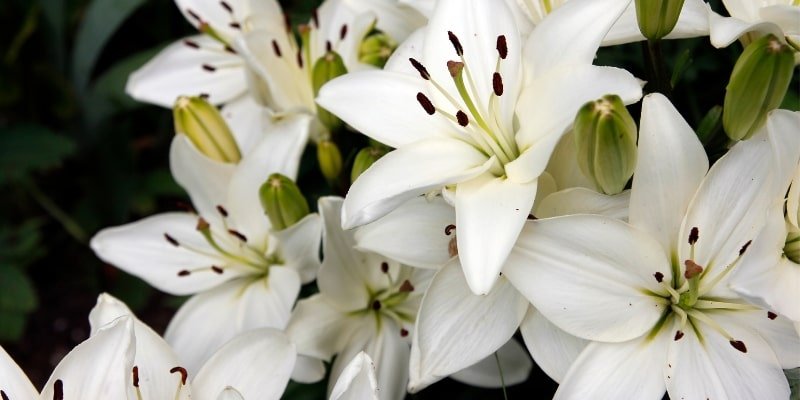
Scientific Name: Lilium
Plant Type: Bulbous Perennials
Plant Size: 1-3 ft / 3-8 ft
Sun Exposure: Full Sun
Geographic Origin: Europe, Asia and North America
Plant Zone: 4 to 9
Lilies are a necessary component of every garden. They provide a wonderful aroma when they flower in the middle to late summer. As long as there is enough water and drainage, lilies can grow in soil types such as chalky, sandy, clay, and loam. They require very little upkeep and enjoy both full and partial sun.
Lilies produce six to eight flowers on a stem and can grow to a height of three to four feet. For optimal images, plant three, six, or twelve bulb sets. Bees and butterflies are drawn to lilies, but cats cannot handle them; they also repel rabbits and deer quite effectively. Lilies grow practically anywhere and are resistant to pests and disease. After they bloom, cut them back.
46. Nicotiana
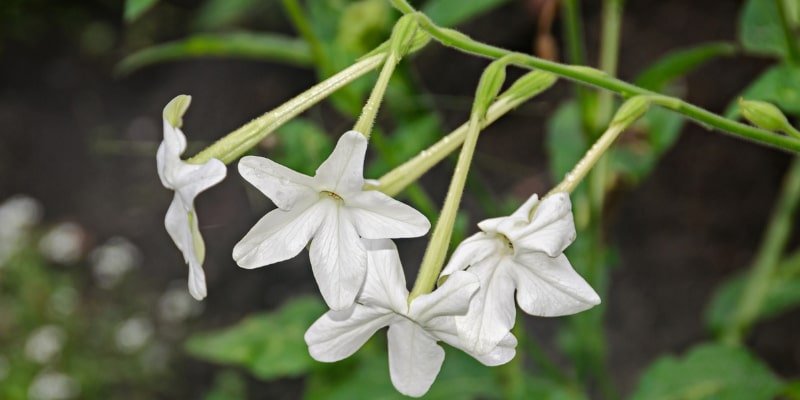
Scientific Name: Nicotiana
Plant Type: Herbaceous perennial
Plant Size: 3-5 ft tall
Sun Exposure: Full sun to Partial shade
Geographic Origin: America
Plant Zone: 9 to 10
Nicotiana is a fragrant, flowering tobacco plant that requires little upkeep. These plants can reach heights of one to three feet and produce flowers that are five inches long. They enjoy both sun and shade and are adaptable.
Nicotiana attracts hummingbirds, butterflies, and pollinating insects and self-propagates through seeds. It grows well in practically any kind of garden and thrives in clay, loam, and calcareous soils with good drainage. Summer and autumn are when the Nicotiana plant flowers.
47. Bacopa
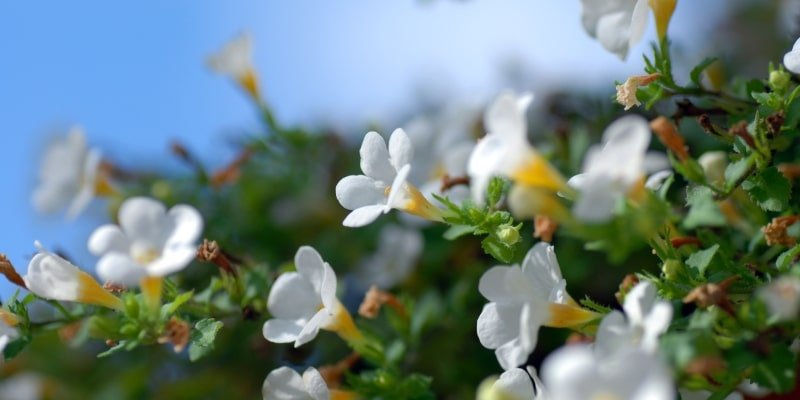
Scientific Name: Bacopa Monnieri
Plant Type: Perennial
Plant Size: 12-36 in tall
Sun Exposure: Partial Shade to Full Shade
Geographic Origin: Australia South America
Plant Zone: 8 to 11
A vast, creeping mat of bacopa, often known as water hyssop, is a perennial semi-aquatic plant. This plant spreads out anywhere from twelve to forty-eight inches and grows twelve to thirty-six inches tall. In warmer climates, it blooms all year round, from mid-spring to the end of autumn.
Water-loving and sun-loving, bacopa thrives in both conditions. It grows quickly and makes a lovely accent in hanging baskets or the garden. It may contain antioxidant qualities that can be used in medicine, and it seldom ever gets sick or draws pests.
48. Steptocarpus
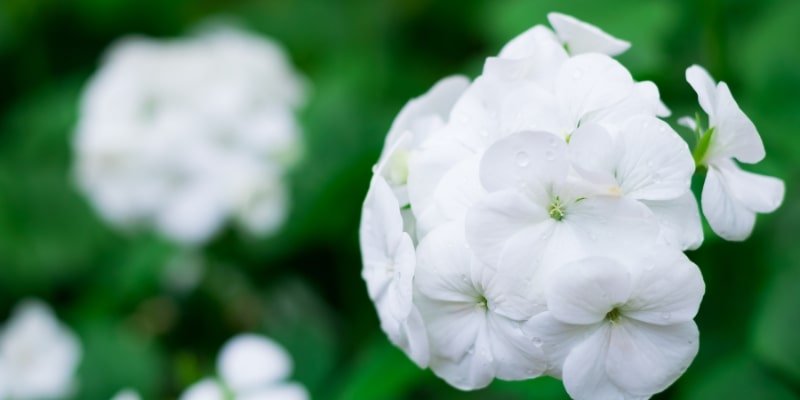
Scientific Name: Streptocarpus
Plant Type: Tropical herbs
Plant Size: 4cm
Sun Exposure: Bright, Dappled sunlight
Geographic Origin: Southern Africa
Plant Zone: 9 to 11
The name of the genus is derived from two Greek words that mean “twisted fruit,” characterizing the form of the plant’s long, slender, tusk-like fruits. Large, glossy, ovate leaves arranged in centre rosettes from which slender stalks emerge characterize Streptocarpus plants. Slightly tubular flowers that mimic orchid blossoms bloom atop these stems.
49. Chrysanthemum
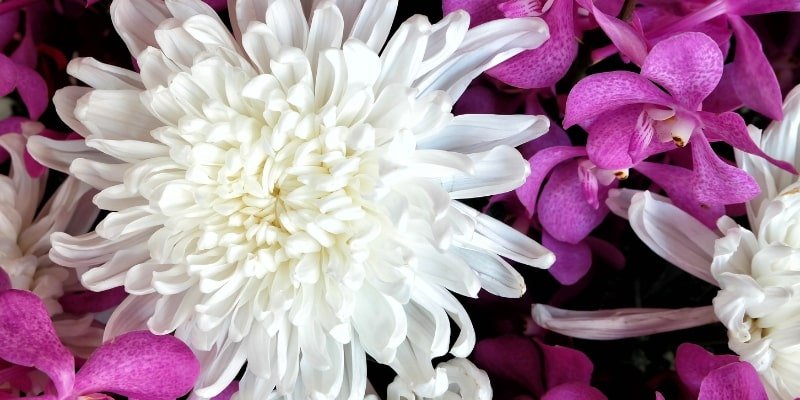
Scientific Name: Chrysanthemum
Plant Type: Perennial
Plant Size: 1-3 feet
Sun Exposure: Full Sun
Geographic Origin: Asia
Plant Zone: 4 to 9
Bushy perennial chrysanthemums have a unique contrast with their dark foliage. They have an approximate height of six to sixteen inches and a width of ten to eighteen inches. The ideal growing conditions for chrysanthemums are full sun and moist clay, loam, or sandy soil with good drainage.
There are numerous blossoms on each stalk of these flowers, which have a diameter of roughly two inches. These are simple-to-cultivate flowers that just need a little fertilizer. Plant them where they will not be exposed to severe winds, then trim them as they develop to help them take on the ideal shape.
50. Osmanthus
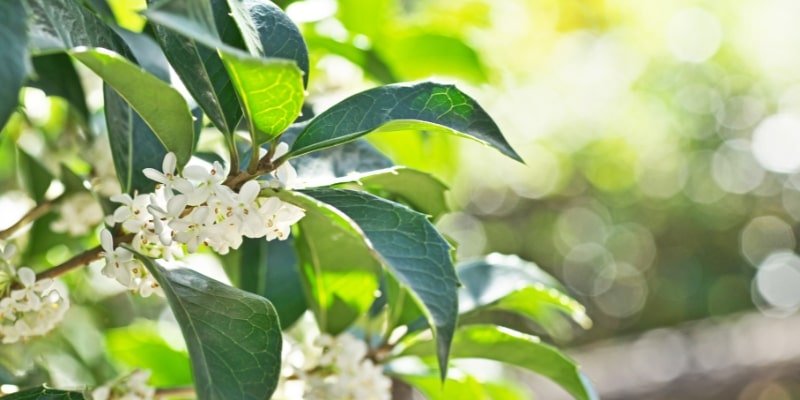
Scientific Name: Osmanthus
Plant Type: Flowering Plant
Plant Size: 3–12 m (9.8–39.4 ft) tall
Sun Exposure: Full sun or partial shade
Geographic Origin: China, Indochina and south Japan
Plant Zone: 8 to 11
The Oleaceae, or olive, plant family includes the genus Osmanthus, which has roughly thirty blooming species. Aside from lovely ovate leaves with a sage colour, these woody shrubs and small trees also have sprays of small white flowers scattered among the leaves along the stems of the plants, which resemble snow clumps balanced on the branches.
51. Hibiscus

Scientific Name: Hibiscus Moscheutos
Plant Type: Perennial
Plant Size: 3-7 ft tall
Sun Exposure: Full Sun
Geographic Origin: Asia and the Pacific islands
Plant Zone: 5 to 8
The sturdy hibiscus is a three- to seven-foot-tall perennial shrub. It spreads two to four feet and loves exposure to the sun. From mid-summer through autumn, hibiscus blooms, forming new buds every day to replace the ones that wither away.
This plant can withstand dryness and damp soil, and it attracts butterflies and hummingbirds. Although it can be vulnerable to leaf spots, rust, canker, beetles, and blights, it is generally resistant to disease and pests.
Hibiscus plants thrive in marshes, swamps, meadows, and wetland forests. They prefer the moist soil found near streams and other bodies of water. This plant thrives in gardens and big pots, and it may be grown in clay and loam soils.
52. Moth Orchid
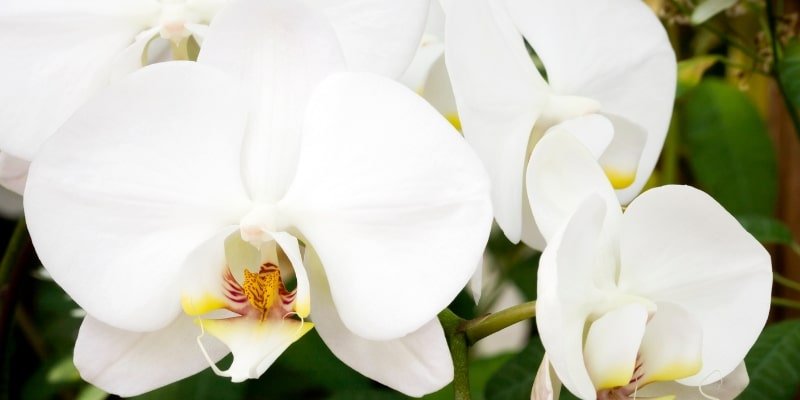
Scientific Name: Phalaenopsis
Plant Type: Tender perennial, epiphyte
Plant Size: 24-36 in. tall (60-90 cm)
Sun Exposure: Indirect sunlight
Geographic Origin: Southeastern Asia and part of Australia
Plant Zone: 6 to 7
The Phalaenopsis genus of the Orchidaceous (orchid) plant family is home to about 70 species of epiphytic plants. Large, waxy leaves in a rich shade of green are produced by these plants at the base.
Long, woody stalks with multiple fragrant, long-lasting flowers blossom from the centre of these leaves. Often referred to as moth orchids, these plants are also occasionally named by their genus name.
53. Winter Heath

Scientific Name: Erica carnea
Plant Type: Health Shrub
Plant Size: 6-12 in. tall (15-30 cm) and 18 in. across (45 cm)
Sun Exposure: Full Sun
Geographic Origin: Western Europe
Plant Zone: 5 to 7
Growing on stony slopes or in forests with coniferous trees, this evergreen sub shrub is a member of the Ericaceae (heath) plant family. A magnificent display of pendulous, bell-shaped, white to deep pink blooms is produced in rows atop the branches, which also have prickly evergreen needles. Other names that are frequently used are winter-flowering heather, alpine heath, and spring health.
54. Dianthus Flowers
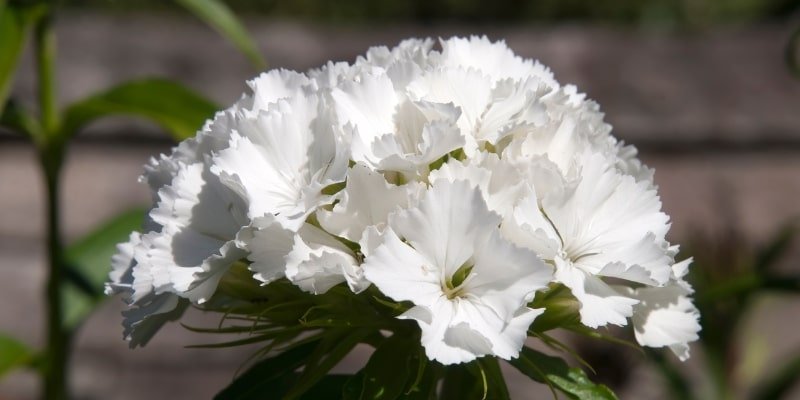
Scientific Name: Dianthus
Plant Type: Annual, Perennial
Plant Size: 10 to 20 inches tall
Sun Exposure: Full Sun
Geographic Origin: Europe and Asia
Plant Zone: 4 to 8
There are over 340 species in the Dianthus genus of the Caryophyllaceae (pink) plant family. Both the well-known Dianthus plumarius and Dianthus caryophyullus species, often known as carnations and pinks, are included in this genus.
The Greek translation of the genus name is “Zeus flower.” Pink, the popular name, is believed to be from an archaic verb form of pink that means to perforate, probably alluding to the petals’ somewhat ruffled or zigzagged edges.
55. Easter Lily
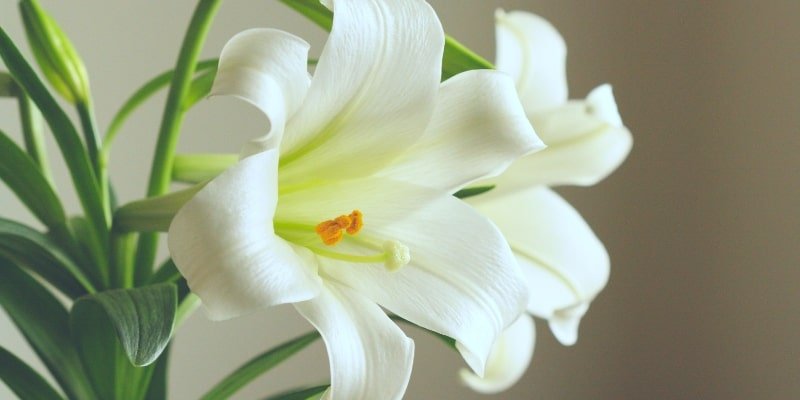
Scientific Name: Lilium longiflorum
Plant Type: Herbaceous flowering
Plant Size: 36 inches tall
Sun Exposure: Full sun to partial shade
Geographic Origin: Ryukyu Islands in southern Japan
Plant Zone: 4 to 8
A species of flowering plant in the Liliaceous (lily) family is Lilium longiflorum. The lily plants have deep-green stalks with long, ovate leaves that extend from the base of the stalk to the top, where clusters of pure-white, star-shaped lily blooms open.
The plants have a maximum height of three feet. Easter lilies are commonly used in Christianity to adorn churches and altars during the Paschal season, as they represent Christ’s resurrection.
56. Snows of Kilimanjaro
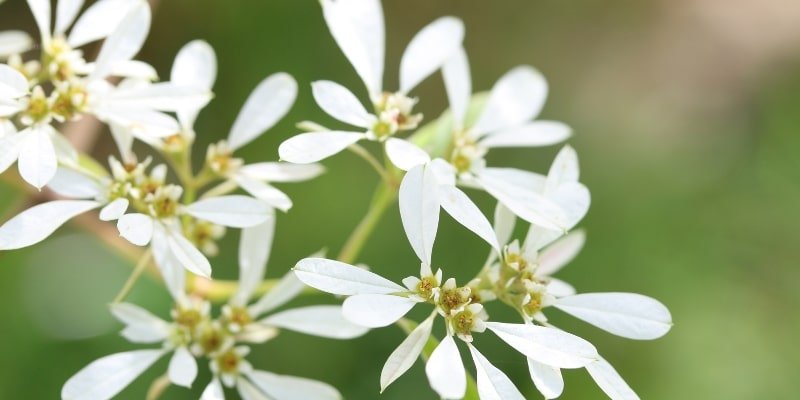
Scientific Name: Euphorbia leucocephala
Plant Type: Spreading shrub
Plant Size: 3m
Sun Exposure: Full sun to partial shade
Geographic Origin: northeastern Tanzania, near the Kenya
Plant Zone: 10 to 13
The plant, which belongs to the Euphorbiaceous (spurge) family, is also known by the common names white lace euphorbia, snow bush, Christmas flower, and snowflake bush. It is also known as the snows of Kilimanjaro. The tree eventually becomes covered in corymbs of tiny, white blooms when in bloom, giving the impression that it has just snowed.
57. Lilac Flowers
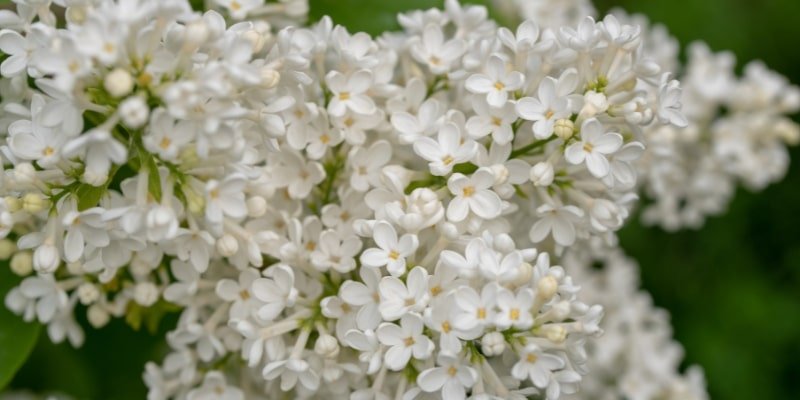
Scientific Name: Syringa
Plant Type: Spring-flowering shrubs
Plant Size: 12 to 15 feet tall and 10 to 12 feet wide
Sun Exposure: Direct Sunlight
Geographic Origin: Asia
Plant Zone: 3 to 8
Twelve flowering plants in the Oleaceae (olive) plant family, commonly referred to as lilacs, are members of the Syringa genus. These plants are woody. Their foliage is gorgeous, being deciduous.
Lilacs are prized and well-cared for their distinctively sweet, traditional scent, even though their massive, cone-shaped clusters of blossoms are only around for a short while. Lilacs bloom in gentle pink, purple, and blue hues in addition to white.
58. Passionflower
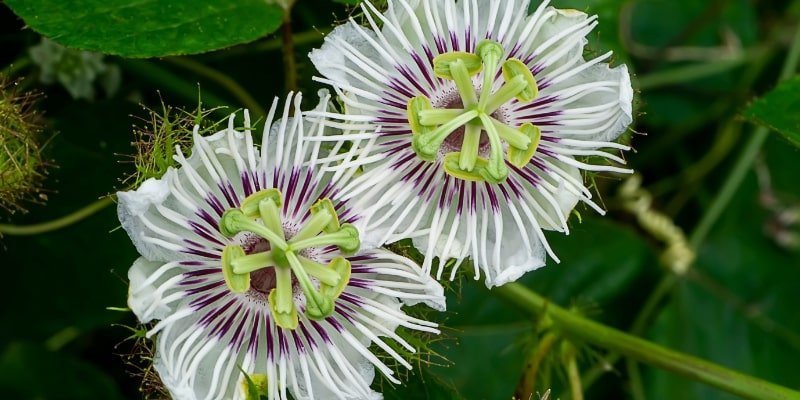
Scientific Name: Passiflora foetida
Plant Type: Herbaceous climber
Plant Size: 36–60 inches
Sun Exposure: Full sun to partial shade
Geographic Origin: Southern States of the USA as well as in Central and South America
Plant Zone: 7 to 11
This evergreen sub shrub belongs to the Ericaceae (heath) plant family and grows on stony slopes or in woods with coniferous trees.
Pendulous, bell-shaped, white to deep pink blooms are produced in rows atop the branches, which also sport spiky evergreen needles, creating a stunning spectacle. Alpine heath, winter-flowering heather, and spring health are among other names that are commonly used.
59. Tuberose
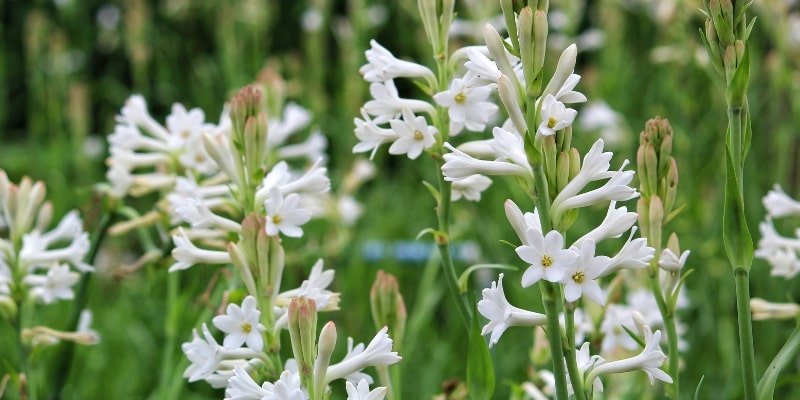
Scientific Name: Agave amica
Plant Type: Perennial, herbaceous
Plant Size: 2 ft
Sun Exposure: Full sun to partial shade
Geographic Origin: Mexico
Plant Zone: 8 to 10
The perennial, herbaceous, flowering agave amica is a member of the Asparagaceae (Asparagus) family of plants. The plants have tuberous roots that grow into long, slender stalks that bloom into trumpet-shaped blooms in cone-shaped racemes.
Although tuberose petals are a beautiful sight to see in gardens, they are also extensively grown for their potent essential oils, which are frequently added to fragrances to impart a floral note.
60. False Goat’s Beard
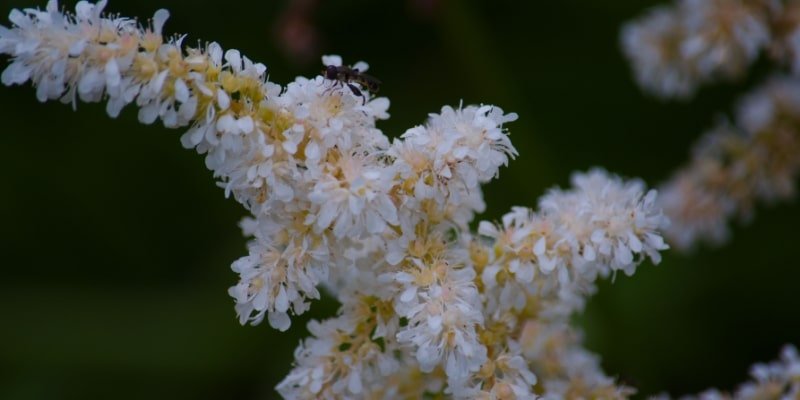
Scientific Name: Astilbe
Plant Type: Herbaceous perennial
Plant Size: 6 inches to 2 feet tall
Sun Exposure: Partial shade to dappled shade
Geographic Origin: North America
Plant Zone: 3 to 9
Astilbe is a genus of eighteen flowering plants that belong to the Saxifragaceae family of plants. They are frequently referred to as fake goat’s beards or counterfeit spire. The plants bear large, flame-like spikes of feathery-looking flowers and clusters of dense, green leaves.
They bloom in pink, purple, crimson, white, and cream hues. Because they thrive in wet environments, they are great plants to plant next to ponds, in clay soil, or in soil that drains slowly.
61. Stephanotis

Scientific Name: Stephanotis
Plant Type: Evergreen woody climber
Plant Size: 5 to 20 feet tall and wide with 3 to 4 inch long
Sun Exposure: Direct Sunlight
Geographic Origin: Madagascar
Plant Zone: 10 to 11
Nine flowering woody vines in the Apocynaceae (dogbane) family make up the Stephanotis genus. Certain species thrive natively in certain areas of their widely dispersed native range. Because of their beautiful, waxy foliage and highly fragrant, white tubular flowers, the plants are frequently grown in tropical gardens or greenhouses.
62. Yarrow Flowers
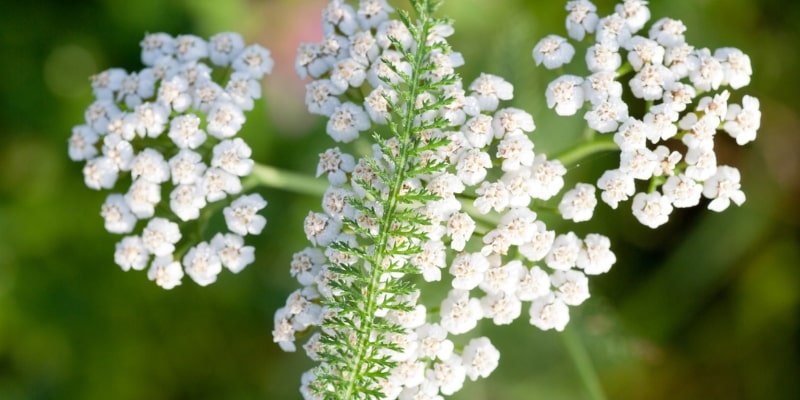
Scientific Name: Achillea millefolium
Plant Type: Flowering plant
Plant Size: 30 cm to 70 cm tall
Sun Exposure: Full Sun
Geographic Origin: Europe and western Asia
Plant Zone: 3 to 9
The plant family Asteraceae includes the herbaceous perennial species Achillea millefolium. The plants bear tiny flowers in flat-topped clusters that are shaped like flat discs. The blooms, which come in shades ranging from white to pink, serve a number of purposes for wildlife, including food for insects and lining for bird nests.
63. Jasmine Flowers
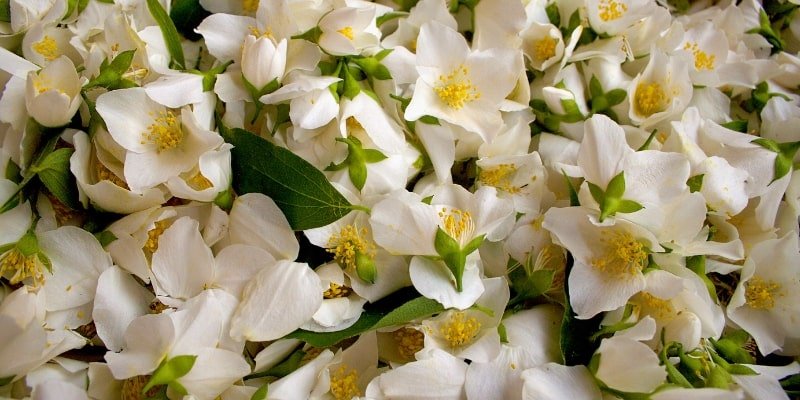
Scientific Name: Jasminum
Plant Type: shrubs and vines
Plant Size: 8-10 m
Sun Exposure: Full sun to partial shaded
Geographic Origin: Eurasia, Africa, Australasia within Oceania,
Plant Zone: 7 to 10
The Jasminum genus of the Oleaceae plant family includes 200 flowering vines and shrubs. The genus includes plants with a wide range of leaf varieties that are both deciduous and evergreen.
Jasmine blossoms typically have a subtle reddish colour, are white, yellow, or flower in clusters, and have a diameter of only about an inch. The little flowers have a strong scent, despite their modest size. Jasmine is used in tea, perfumes, and various cultural customs in addition to being grown as a decorative plant.
64. Columbine Flowers
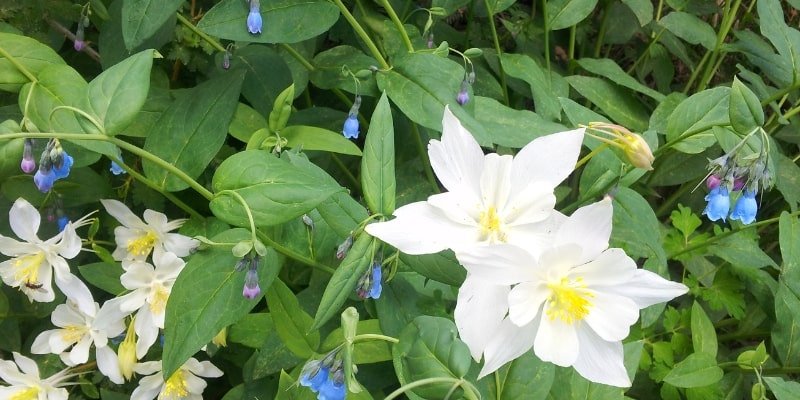
Scientific Name: Aquilegia
Plant Type: Herbaceous Perennial
Plant Size: 12-36 in. tall, 12-24 in. wide
Sun Exposure: Full sun to dappled shade
Geographic Origin: Europe and North America
Plant Zone: 3 to 8
The genus Aquilegia contains between 60 and 70 species of perennial herbaceous plants. The genus’s hybrids and cultivars have been developed to be even more remarkably elaborate, with multicoloured inflorescences that feature layers of various forms, textures, and hues in a range of combinations containing white. Columbine blooms are known for their characteristic spurred petals.
65. Bellflowers
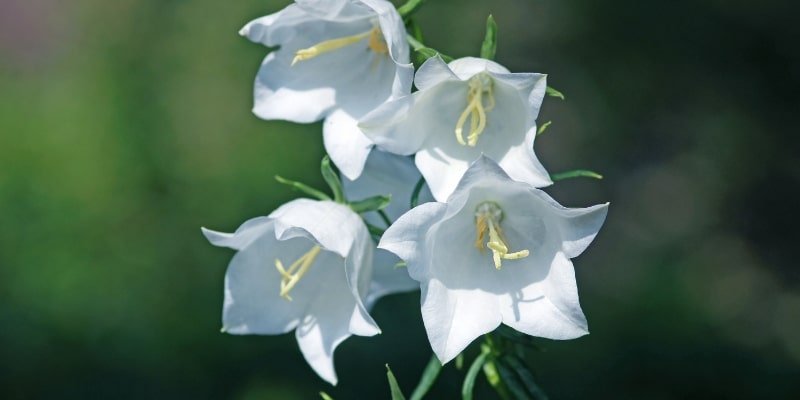
Scientific Name: Campanula
Plant Type: Annual, perennial, and biennial herbs
Plant Size: 3 inches (8cm)
Sun Exposure: Full sun to partial shade
Geographic Origin: Western Eurasia
Plant Zone: 3 to 8
These plants, which go by the common name bellflowers, acquire their popular name from the bell-like shapes of the flowers they produce, as well as their scientific genus name, which is Latin for “little bell.”
The Middle East and the Caucuses are home to the majority of bellflower species. Nonetheless, certain indigenous species can be found growing in temperate and subtropical climates across the Northern Hemisphere.
A wide range of annual, biennial, and perennial blooms are found in this genus. Some kinds bloom in blue, purple, and pink in addition to white.
66. Peruvian Lily
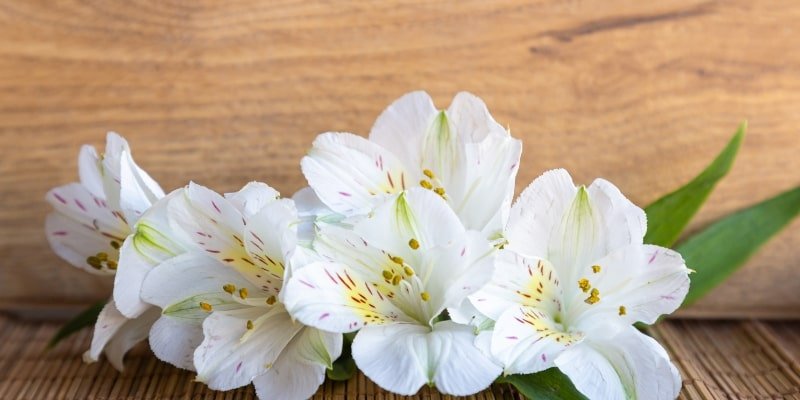
Scientific Name: Alstroemeria
Plant Type: Perennial
Plant Size: 1–3 ft. tall, 1–2 ft. wide
Sun Exposure: Full Sun
Geographic Origin: South America
Plant Zone: 8 to 10
Alstroemeria is a genus of flowering plants in the Alstroemeriaceae plant family that contains roughly 50 species (plus hundreds more cultivars and hybrids). They go by the names Peruvian lily or lily of the Incas and are mainly long-living perennials.
These blooms bloom in varieties of pink, red, orange, purple, and green, in addition to white, atop tall stalks. Darker brown and black spots, stripes, and speckles adorn the blooms.
67. Woodland Tobacco

Scientific Name: Nicotiana Sylvester’s
Plant Type: Perennial
Plant Size:
Sun Exposure: Full Sun, Partial or dappled shade.
Geographic Origin: North and South America
Plant Zone: 9 (-7 bis -1 °C)10 (-1 bis 4 °C)11 (4 bis 10 °C)
Alstroemeria is a genus of flowering plants in the Alstroemeriaceae plant family that contains roughly 50 species (plus hundreds more cultivars and hybrids). They go by the names Peruvian lily or lily of the Incas and are mainly long-living perennials.
These blooms bloom in varieties of pink, red, orange, purple, and green, in addition to white, atop tall stalks. Darker brown and black spots, stripes, and speckles adorn the blooms.
68. Japanese Andromeda
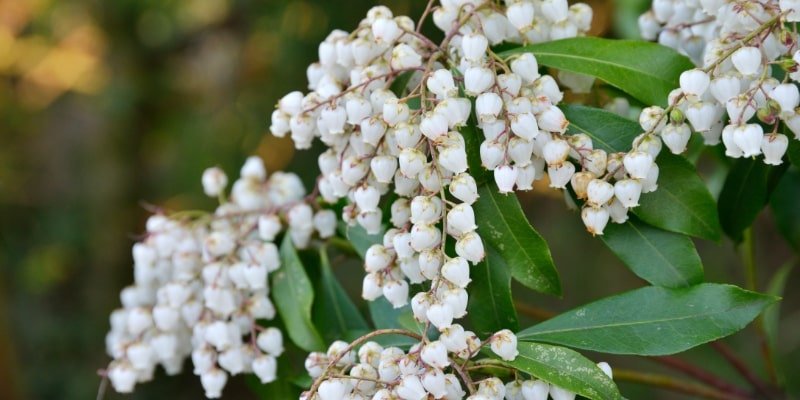
Scientific Name: Pieris japonica
Plant Type: Evergreen shrub
Plant Size: 9-12 ft. tall, 6-8 ft. wide
Sun Exposure: Full Sun
Geographic Origin: Eastern China, Taiwan, and Japan
Plant Zone: 5 to 8
Pieris japonica, a flowering plant species with a maximum height of 13 feet, is a member of the Ericaceae (heath) plant family. It originated in the hilly regions of eastern Asia.
They have a basic leaf, but they appear either red or bronze at first and then turn a rich shade of green. In addition, this plant bears exquisite clusters of hanging urn-shaped blooms in soft pink, cream, and white hues that spread like fingers.
69. False Shamrock
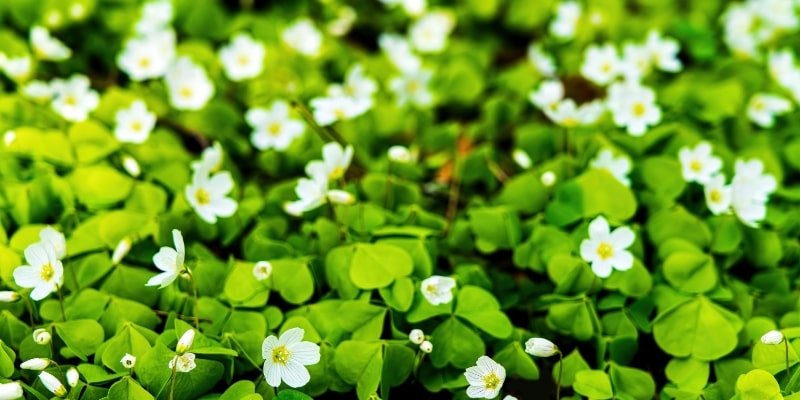
Scientific Name: Oxalis triangularis
Plant Type: Perennial
Plant Size: 6-12 in. tall (15-30 cm) and 12-24 in wide (30-60 cm)
Sun Exposure: Full sun to partial shade
Geographic Origin: South America
Plant Zone: 7 to 10
Oxalis triangularis is a perennial flowering plant native to southern South America that belongs to the Oxalidaceae (wood sorrel) plant family. Often referred to as false shamrock, this plant has three leaflets on either dark purple or green leaves that are frequently mistaken for real shamrock.
The plant spreads readily by means of its tuberous rhizomatic root systems and yields little, star-shaped, white flowers with five petals each.
70. Queen Anne ’s lace
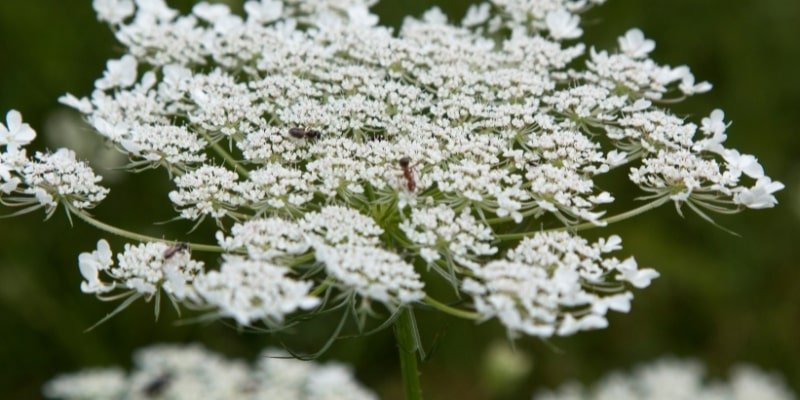
Scientific Name: Daucus carota
Plant Type: Biennial herbaceous
Plant Size: 1.5 meters (5 feet) tall
Sun Exposure: Full Sun
Geographic Origin: Eurasian
Plant Zone: 3 to 9
Daucus carota is a native of the Old World’s temperate areas. It is an herbaceous flowering plant belonging to the Apiaceae (carrot) family. Bishop’s lace, bird’s nest, and wild carrot are some of its common names.
This plant certainly possesses wonderful traits, if any plant can be said to have such features. The delicate, small white petals that resemble lace are included in the corymbs of Queen Anne’s lace flowers, which have leaves with exquisite shapes akin to embroidered lace. The aroma of the leaf is somewhat carroty and fresh.
71. Christmas Rose
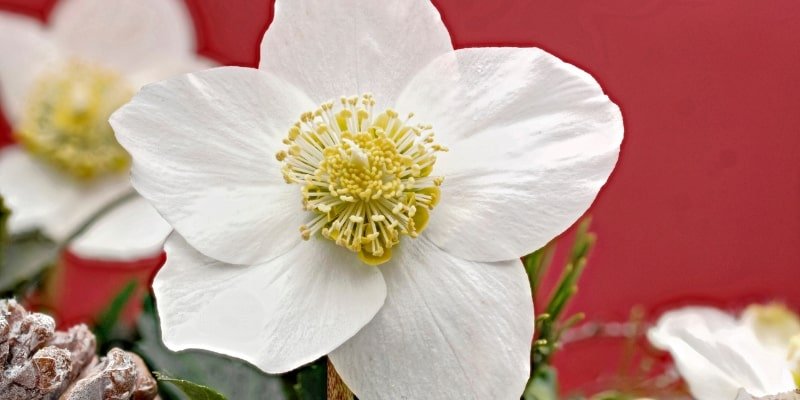
Scientific Name: Helleborus Niger
Plant Type: Perennial
Plant Size: 1 to 2 feet tall and wide
Sun Exposure: Full Sun
Geographic Origin: Europe
Plant Zone: 3 to 9
A species of evergreen perennial plant in the Ranunculaceae family is called Helleborus Niger. Although it is highly toxic, it yields stunning, star-shaped flowers with snow-white petals and vivid yellow centres. Because of the plant’s black roots, this species is frequently referred to as the black hellebore, in addition to the Christmas rose.
72. Creeping Dogwood
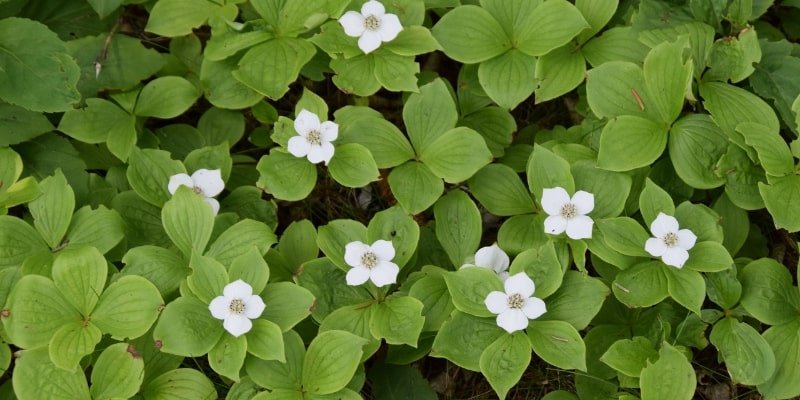
Scientific Name: Cornus Canadensis
Plant Type: Perennial
Plant Size: 6 inches
Sun Exposure: Full Sun
Geographic Origin: Europe, eastern Asia, and North America
Plant Zone: 2 to 7
A plant belonging to the Cornaceae (dogwood) family. The floral plant grows slowly and creepingly. Short, star-shaped rosettes of four to eight-inch-tall spade-shaped leaves are produced from rhizomes, and it is from these rosettes that solitary, white flowers with four petals bloom.
In sections of your garden that you don’t intend to have people walk on, these well-liked seasonal blooms provide an eye-catching ground cover. The plant is also known by various common names, including Canadian bunchberry, quarter-temps, Canadian dwarf cornel, and cracker berry, in addition to creeping dogwood.
73. Primrose Flowers
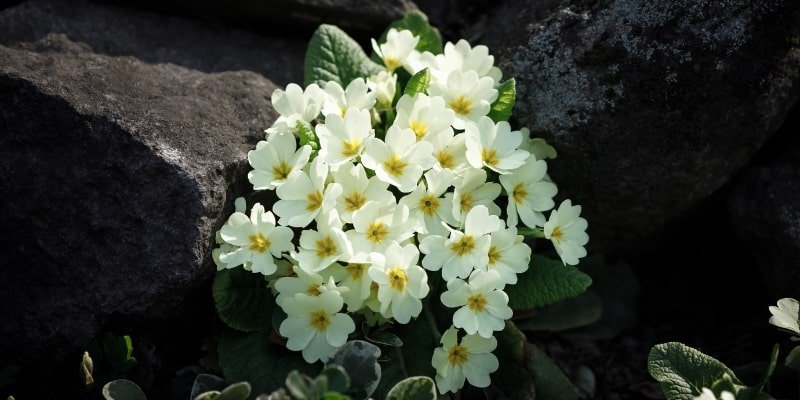
Scientific Name: Primula vulgaris
Plant Type: Perennial herbs
Plant Size: 4-6 inches (10-15 cm) tall
Sun Exposure: Full Sun, Partial shade
Geographic Origin: Europe and parts of Africa and Asia
Plant Zone: 3 to 8
A species of flowering plant in the Primulaceae (primrose) family of plants is Primula vulgaris. Known by several names, such as English, common, or primrose, they are characterized by a rosette of foliage that produces multiple flowers in the early spring. Though they can occasionally be pink, the blossoms are usually white and yellow. White flowers are also available on Japanese primrose.
74. Alexander’s White Candytuft
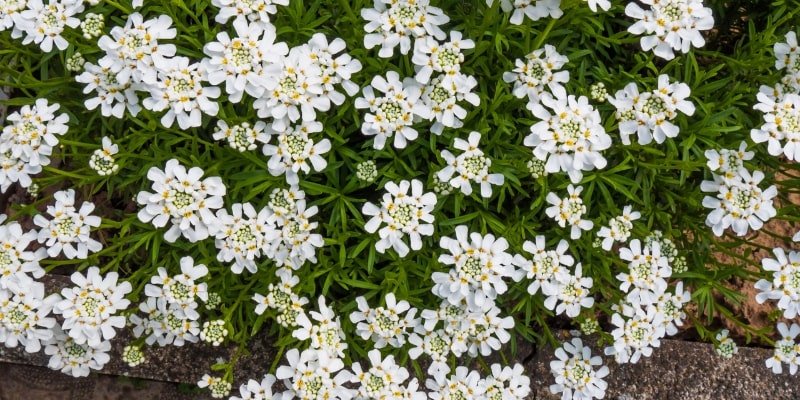
Scientific Name: Iberis sempervirens
Plant Type: Herbaceous perennial
Plant Size: 6-12 tall
Sun Exposure: Full Sun
Geographic Origin: Europe
Plant Zone: 3 to 8
Alexander’s White Candytuft produces stunning, dense ground cover in April and May, when it bursts into multi-flowered tufts. Clusters of the four-petaled blooms are growing together, and the creamy white carpet is brightly coloured with a lovely yellow centre. The semi-woody stems of these plants grow slowly and frequently produce new roots at the ground’s surface.
Because moist soil can cause crown rot, this perennial shrub prefers sun and well-drained soil. Their growth ranges from zones 3 to 8, where they remain evergreen in regions with milder winters and semi-evergreen in those with harsher ones.
Although deer and rabbits avoid Alexander’s White Candytuft, it is highly appealing to butterflies. Anticipate plants to reach a maximum height of 12 inches, particularly when placed in direct sunlight.
75. Great White Trillium
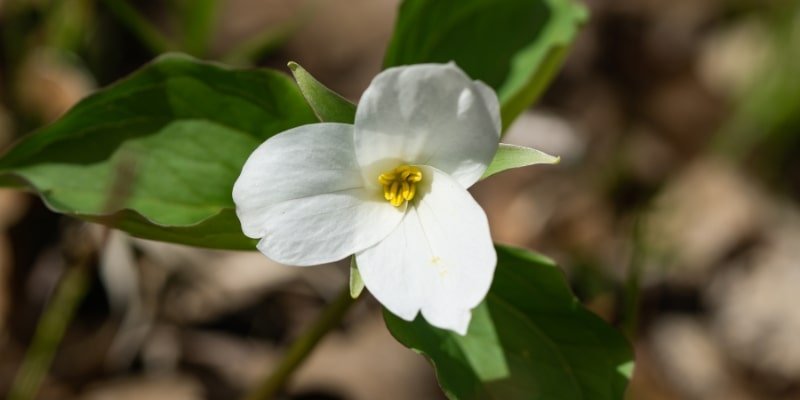
Scientific Name: Trillium grandiflorus
Plant Type: Perennials
Plant Size: 15 to 45 cm tall
Sun Exposure: Full Sun (light or open shade)
Geographic Origin: North America and Asia
Plant Zone: 4 to 8
The Great White Trillium is a wildflower that grows wild in the forests of the eastern United States. However, home gardeners can easily incorporate it into their house’s flora mix. Because their leaves, petals, and seedpods grow in threes, they are sometimes called Trinity Flowers.
It’s interesting to note that they are sometimes called Wake Robins since they usually flower right before robins head back to their woodland homes.
The Great White Trillium is unique among the more than 40 kinds of trillium in that it can change its colour. The petals change from their stunning, dazzling white to salmon pink as the flowering season draws to a close, offering a pop of colour to mark the start of summer.
76. Peter Cottontail
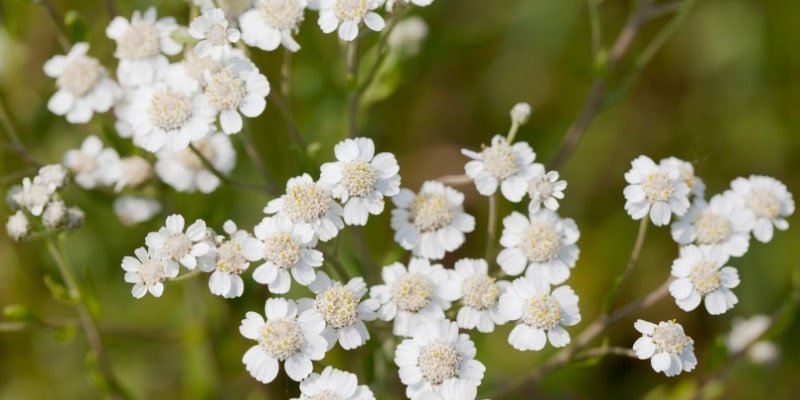
Scientific Name: Achillea ptarmica
Plant Type: Perennials
Plant Size: 18-24 in. tall
Sun Exposure: Full Sun
Geographic Origin: Europe and western Asia
Plant Zone: 3 to 8
Peter Cottontail, also known as “Sneezewort,” is a long-blooming, medium-sized bush that has fluffy flower clusters that resemble bunny tails. It is a variation on the traditional yarrow. They resemble Baby’s Breath in every way, including their cold white colouring.
In zones 3–8, yarrow grows very easily, provided it has access to lots of sun and well-drained soil. They thrive in poor-quality soil and don’t require much more fertilizer. Early summer is when you should expect to see the first puffs, which continue until late autumn.
77. Mountain Mint
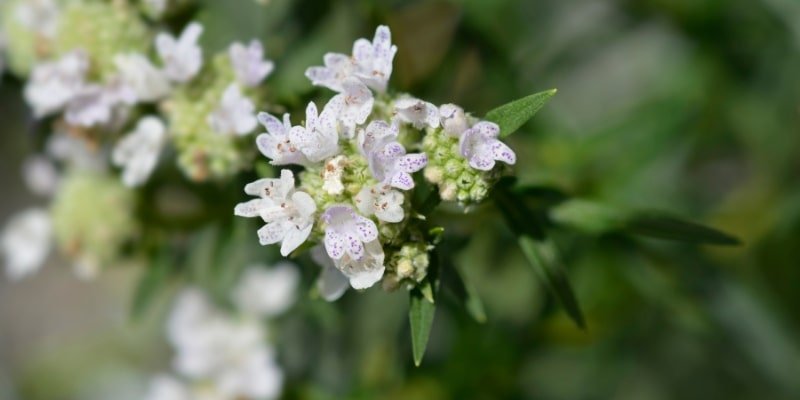
Scientific Name: Pycnanthemum virginianum
Plant Type: Herbaceous Perennials
Plant Size: 1-3 feet
Sun Exposure: Prefers full sun, but tolerates light shade
Geographic Origin: United States and North America
Plant Zone: 4 to 8
Mountain mint produces white blooms with lavender-tinged freckles and fresh, aromatic leaves that are both beautiful and useful in equal measure. The inflorescence is a real cornucopia for fly-by pollinators, made up of closely spaced clusters of buds with varying bloom timings.
But home gardeners can encourage the growth of this fragrant perennial by providing it with full light and lots of water. You may even muddle a few leaves to add some coolness to iced tea or juleps.
78. Honorine Jobert Japanese Anemone
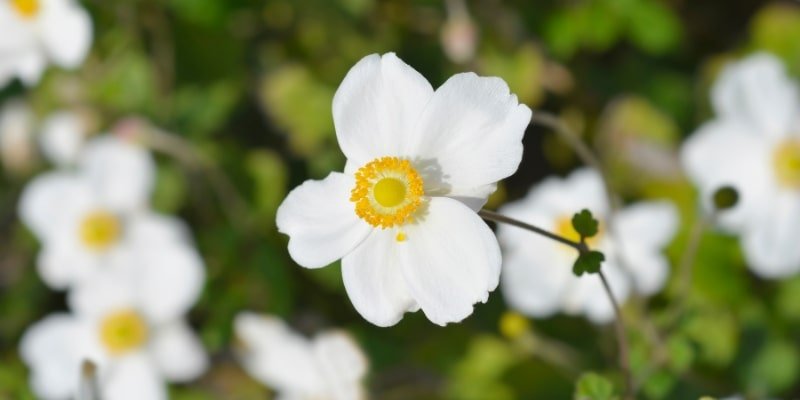
Scientific Name: Anemone x hybrida
Plant Type: Herbaceous perennials
Plant Size: 3-4 tall
Sun Exposure: Full Sun
Geographic Origin: Verdun, France
Plant Zone: 4 to 7
The Honorine Jobert Japanese Anemone is a late-season show-off with softly cupped white petals and an eye that is sage green with orangish-yellow stamens surrounding it. Because of their thin, frail stems, they have a tendency to swing in even the slightest breeze, hence their popular name, windflower. They bring lovely colour to gardens all autumn through late summer.
Ideal for slow-growing anemone blossoms, which are mostly, produced when the plants are placed in full sun on normal, clay, or acidic soil. Because they can withstand a lot of wetness, give them plenty of water. Cut down the blackened leaves and shield the roots for years of flowers if you have cold winters.
79. Caribbean Spider Lily
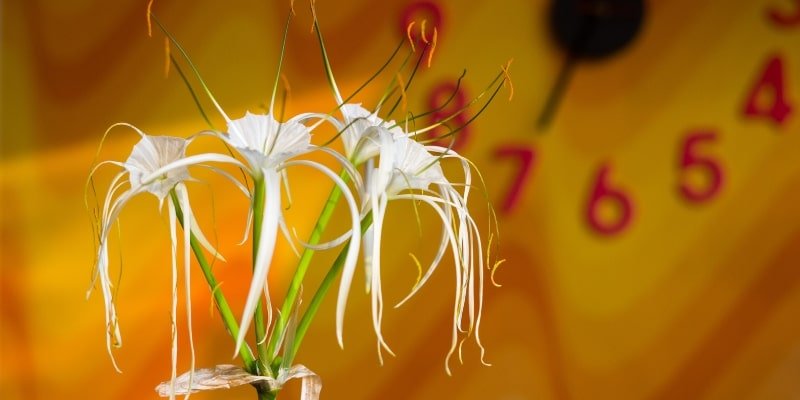
Scientific Name: Hymenocallis caribaea
Plant Type: Herbaceous perennials
Plant Size: 12-18 in. tall (30-45 cm) and 12 in. wide (30 cm)
Sun Exposure: Full Sun, Partial Sun
Geographic Origin: China, Japan, Korea and Nepal
Plant Zone: 7 to 11
The Caribbean Spider Lily, in contrast to its namesake, has a central cup shaped like a daffodil with six long, spindly petals that give off a rich vanilla scent. Butterflies are among the pollinators attracted to its lovely scent. They can grow to a height of three feet and produce flowers in the middle to late summer.
The spider lily is native to the Caribbean Islands and Central America, where it thrives best in full sun and moist soil. But those with harsher winters should move the bulbs indoors and replant in the next growth season.
80. Foamflower
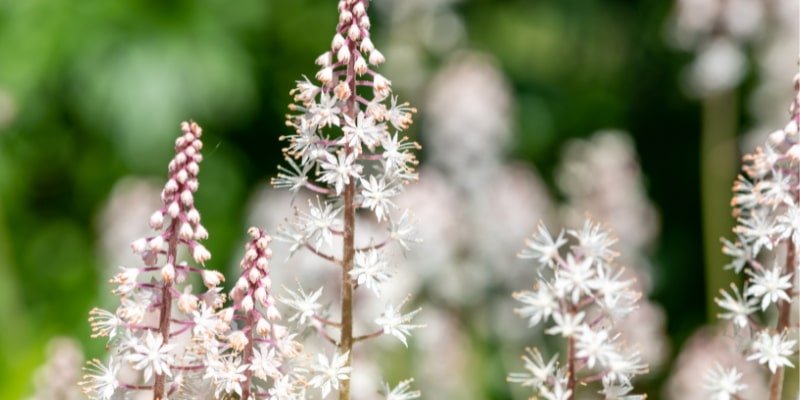
Scientific Name: Tiarella cordifolia
Plant Type: Perennial
Plant Size: 12 in. tall (30 cm) and 12-24 in. wide (30-60 cm)
Sun Exposure: Full Sun
Geographic Origin: Eastern North America
Plant Zone: 3 to 8
These natural runners from North America are often used as border, filler, and foliage plants. In warmer areas, the evergreen Foamflower forms slender spires of strikingly green leaves with rich red centers.
The exquisitely decorated chocolate-coloured veins of the bottlebrush blossoms, which bloom throughout the spring and summer, create a striking contrast with the creamy white clusters of blooms. Make sure your plants are planted in places with lots of shade and well-retaining, humus-rich soil.
81. Foxglove Beardtongue
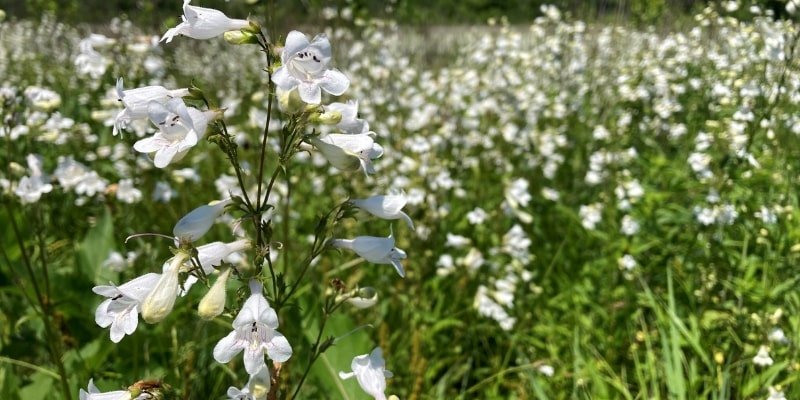
Scientific Name: Penstemon laevigatus ssp. Digitalis
Plant Type: Herbaceous Perennials
Plant Size: 3-5 tall
Sun Exposure: Full Sun
Geographic Origin: North America
Plant Zone: 3 to 8
The 1-inch bell-shaped Foxglove Beardtongue flower, which blooms in May, June, and July, is popular among pollinators and gardeners. Their colour varies from white to blush pink, and hummingbirds and bees are drawn to their deep purple throats.
Foxglove although bearded tongue is indigenous to the Mississippi Basin, it may thrive in a wide range of environments, including dry, mild, and wet soil. They do not like alkaline soil, although they do better in acidic soil.
82. Misty Lace Goatsbeard
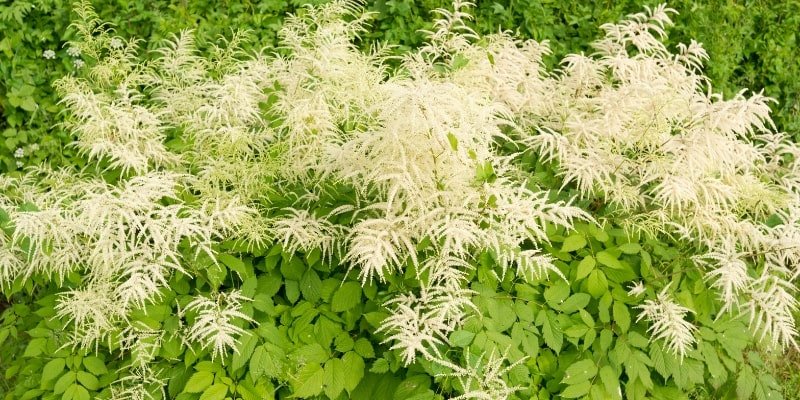
Scientific Name: Aruncus
Plant Type: Herbaceous Perennials
Plant Size: 6 inch
Sun Exposure: Full sun or part shade
Geographic Origin: Western and central Europe, Russia, and the Caucasus
Plant Zone: 3 to 8
Velvet Lace if you have a small garden, goats beard’s fern-like fronds and wispy white foliage add a rustic tactile element to your beds. For extra visual interest, they have stems that are noticeably deep crimson. Mounds of lush foliage are left behind as the blooms fade after blossoming in the heat of summer and mild autumn.
Velvet Lace As long as the plant is planted in well-fertilized soil that holds water, goats beard can thrive even in hot, humid areas.
83. Star Jasmine
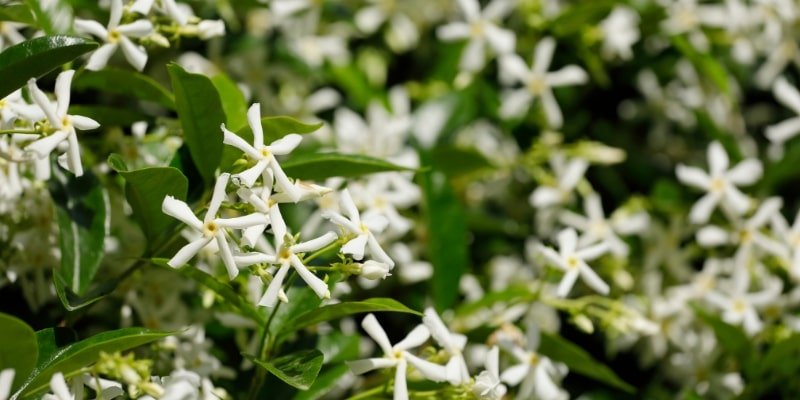
Scientific Name: Trachelospermum jasminoides
Plant Type: Shrubs and vines
Plant Size: 3–6 ft. tall, 3–6 ft. wide
Sun Exposure: Full Sun
Geographic Origin: Admiralty Islands of Papua New Guinea
Plant Zone: 8 to 11
The Star Jasmine is a sensory experience named for its star-shaped arrangement of five petals. It is the most often used type of jasmine. Bees are drawn to feast on the aromatic blossoms in late spring and early summer. After its initial growth season, it can grow vertically up to six feet a year.
Keep the soil loamy and medium-moisture, and provide ample sunlight for it. When the weather is suitable for it to grow, it will grow in pots above its ideal growing zone and handle transfer well. Because they have had a full year to establish themselves, you should only fertilizer after that.
84. White Prosperity Gladiolus
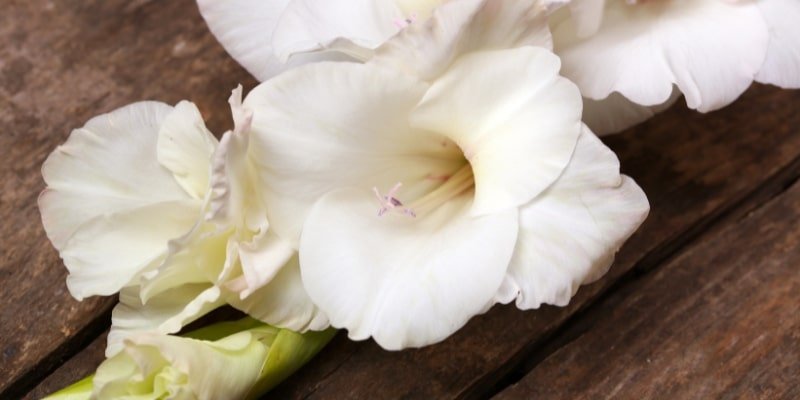
Scientific Name: Gladiolus x hortulanus
Plant Type: Herbaceous perennial
Plant Size: 4-5 ft. tall
Sun Exposure: Full Sun
Geographic Origin: South Africa
Plant Zone: 8 to 11
The well-known “Sword Flower” is a striking, vividly white choice with layers of ruffled leaves that contrast with the spike-like stem and sharper foliage. They are a popular flower for summer weddings and can add a touch of refinement to a bouquet of flowers cultivated at home because they are elegant and upright. They can grow up to five feet tall, with the higher plants bearing much larger flowers.
As long as the soil is well-drained and humusy, with a low percentage of clay, you can attain ideal growth. Be advised that gladiolus need twice as much water during flowering, which lasts around two weeks. To extend their beauty, you can space out your plantings every two weeks, starting with the last frost and continuing until the end of May. New florets will open as the older ones wither.
85. Masterwort
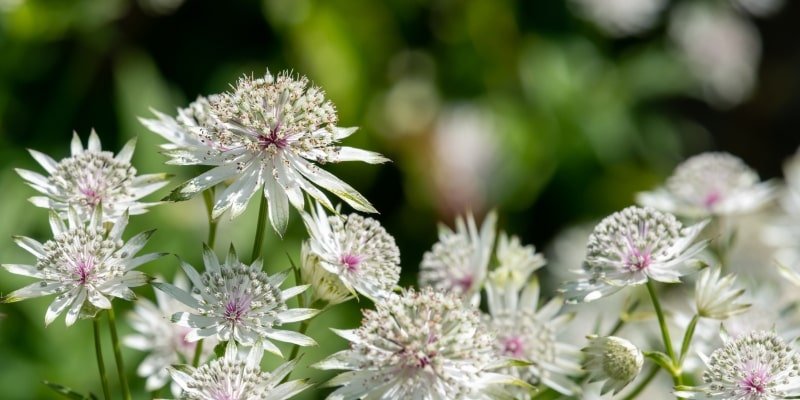
Scientific Name: Gladiolus x hortulanus
Plant Type: Herbaceous perennial
Plant Size: 90 cm (35 in) tall by 45 cm (18 in)
Sun Exposure: Full Sun, Partial Sun
Geographic Origin: Central and Eastern Europe
Plant Zone: 4 to 9
Sprinkle some pink-speckled ivory masterwort on your white perennial blooms to give them some variation. The pincushion floret centre of the firework-shaped blooms, encircled by paper-thin flat petals, adds a whimsical and charming touch. They are somewhat short, reaching a maximum height of two feet in ideal soil circumstances.
Plant in rich, wet soil with lots of shade. They have a low threshold for drought and will perish rapidly in an overly dry bed. Depending on the quantity of naturally occurring organic material in your garden soil, they also need fertilization every two years.
86. Festiva Maxima Peony
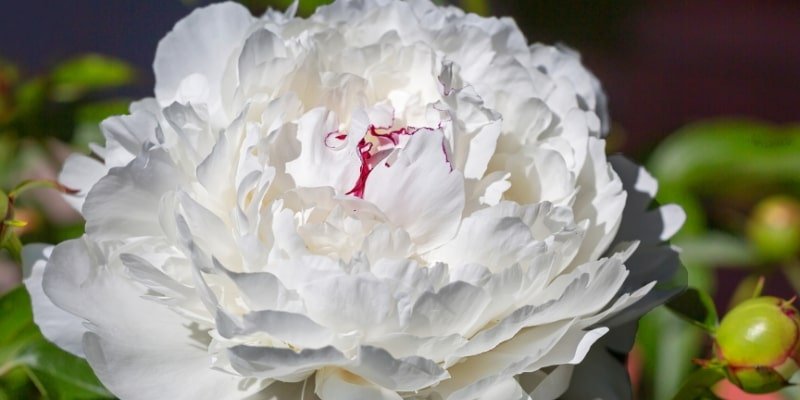
Scientific Name: Paeonia Lactiflora
Plant Type: Perennial
Plant Size: 34-36″ tall x 24-36″ wide
Sun Exposure: Full Sun or Part Shade
Geographic Origin: Asia, Europe, and Western North America
Plant Zone: 3 to 8
The Festiva Maxima Peony is a stunning centrepiece with softly curving petals that are flecked with a carmine blush along their frilly edges. Even in inclement weather, they bloom for a week or more in late spring and early summer, making them a transient but dependable beauty.
The foliage of peonies is widely recognized for its ability to change colour with the seasons, require little care, and last for many generations. So that the roots have time to establish themselves before the blooming season, plant in the early autumn in wet, well-drained soil.
87. Cape Jasmine Gardenia
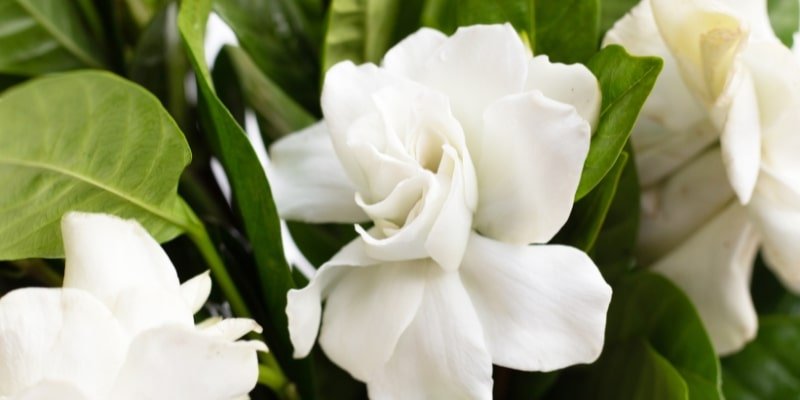
Scientific Name: Gardenia jasminoides
Plant Type: Shrubs
Plant Size: 30 cm
Sun Exposure: Full sun to light shade
Geographic Origin: China
Plant Zone: 8 to 11
The Cape Jasmine Gardenia, when grown in the right conditions, can reach a maximum diameter of 4 inches and boasts enormous, beautiful petals together with glossy green leaves. It is truly a breathtakingly cut flower. Known as a symbol of the South, this flower was among the first to be filed with the US Plant Patent Office.
The strong gardenia fragrance produced by the rose-like double blooms lingers throughout the early spring and summer, along with the blooms.
It thrives in zones 7-9 in the warm, humid summers because of its growing requirements. To get the most flowers, these shrubs need full sun and acidic soil. They are also excellent indoor shrubs.
88. Galaxy White
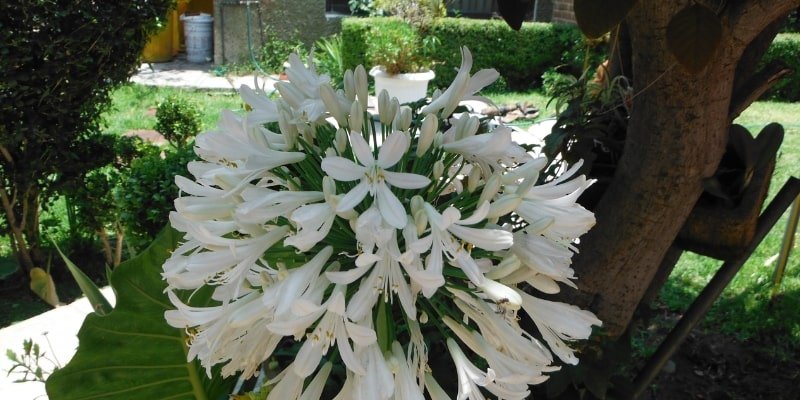
Scientific Name: Agapanthus Africanus
Plant Type: Rare Perennial
Plant Size: 3′ tall x 3′ wide
Sun Exposure: Full Sun
Geographic Origin: South Africa
Plant Zone: 8 to 10
Galaxy White, also called the African lily or the Lily of the Nile, bears stunning clusters of milky white trumpets with a dark stamen that contrasts with the yellow throat. This plant’s robust stalks make it perfect for borders, creating a natural wall with tactile puffs of blossoms and buds on top.
If a layer of mulch is applied to protect them, these blooms show dependable overwintering. They want a little shade, at least six hours of direct sunlight each day, and a reasonable amount of moisture. The late spring to midsummer months are when Galaxy White is most beautiful.
89. Snowdrop Anemone
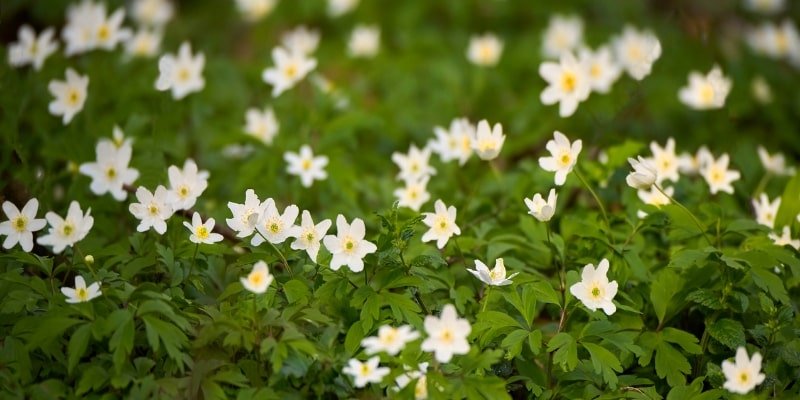
Scientific Name: Anemone Sylvester’s
Plant Type: Perennial
Plant Size: 12 to 18 in. tall, spreading 12 in. wide
Sun Exposure: Sun to full shade
Geographic Origin: Northern Europe
Plant Zone: 3 to 8
The Snowdrop Anemone shares characteristics with its sister subspecies, the Honorine Jobert Japanese Anemone, including gently cupped alabaster petals with a canary yellow centre. They are distinctive in that the main body’s undersides emit a stunning blush from an ombre purplish-green stem.
Native to sylvan environments, snowdrop anemones flourish beneath shade trees, where they will enthusiastically proliferate in loose, sandy soil. They can easily survive the winter and emerge with their woolly heads in the late spring or early summer since they are incredibly resilient to the cold.
90. Shasta Daisies
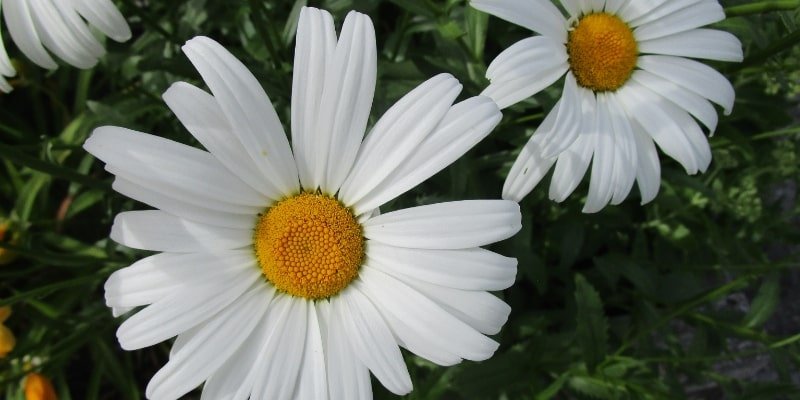
Scientific Name: Leucanthemum × superbum
Plant Type: Perennial
Plant Size: 24-30 inches
Sun Exposure: Full sun to light shade
Geographic Origin: Europe and Asia
Plant Zone: 4 to 9
No list of white perennial flowers would be complete without the Shasta daisy. With a bright stamen clustered in a ring of petals the colour of just-fallen snow, it’s a timeless favourite. When combined with more dramatic flora, Shasta daisies provide a delightful visual contrast. They have great ornamental value.
Shasta daisies may stay evergreen in zones 5 through 9, which are warmer climates. However, frost can be quite deadly, so do not plant until early spring in areas with full sun and good drainage. You run the danger of losing your daisies before them bloom, so avoid planting in the autumn.
91. Diamond Frost
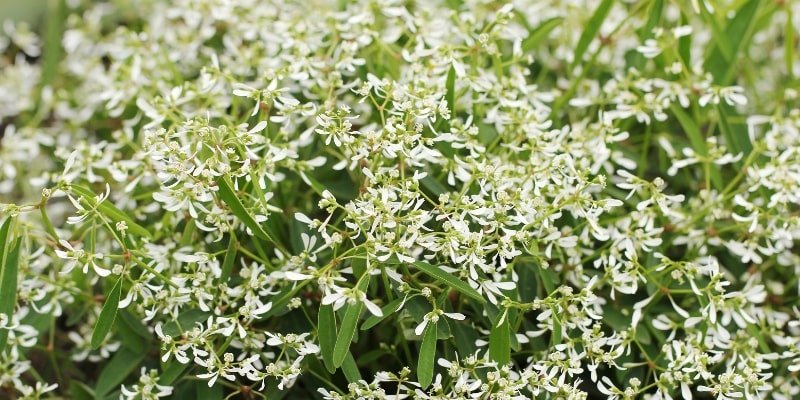
Scientific Name: Euphorbia hypericifolia
Plant Type: Hybrid perennials or annuals
Plant Size: 12-20 inches tall
Sun Exposure: Full sun to part shade
Geographic Origin: America
Plant Zone: 10 to 12
Frost® Diamond Hybrid perennials or annuals, Euphorbias, have dark green foliage with a striking scarlet flush. The beautiful bracts last for a long bloom season, from spring until the first frost, despite the tiny flower heads.
Plant in fully shaded to partially shaded soil that drains nicely. They can withstand heat and drought, and they are not easily browsed by rabbits or deer. Deadheading is not necessary for these low-maintenance plants to have an extended bloom season. Pinch to promote a bushy growth habit, particularly when growing in pots.
92. Sweet William
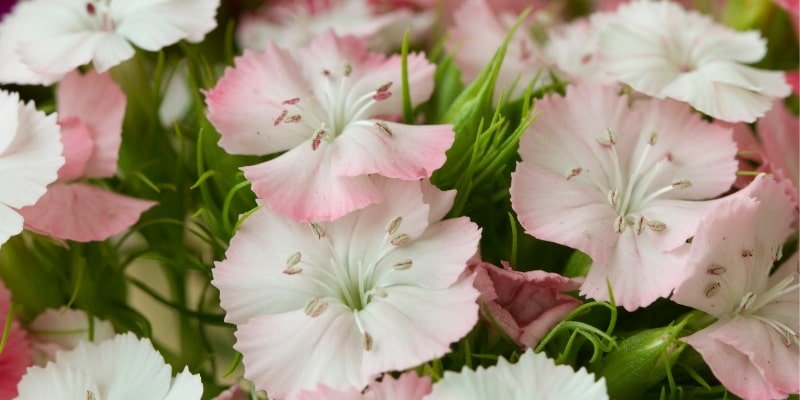
Scientific Name: Dianthus barbatus
Plant Type: Perennial
Plant Size: 20 in. tall (50 cm) and 6-12 in. wide (15-30 cm)
Sun Exposure: Full sun
Geographic Origin: Southern Europe and parts of Asia
Plant Zone: 3 to 9
Dianthus barbatus, sometimes known as sweet willow, is a pink garden plant belonging to the Caryophyllaceous family that is planted for its clusters of tiny, vibrantly coloured blooms. It is often grown as a biennial, with seeds planted in the first year that blossom in the second.
Reaching up to 60 cm (2 feet) in height, the plant bears several flowers with fringed petals that are white, pink, rose to violet, or even bicoloured. For its cut blooms, it is used in the floral industry. The bloom is referred to as sour Billy or stinking Willie in Scotland.
93. Profusion Salvia

Scientific Name: Salvia nemorosa
Plant Type: Woodland sage
Plant Size: 16-20
Sun Exposure: Full Sun
Geographic Origin: Oaxaca, Mexico
Plant Zone: 3 to 8
Sweet William is a pink-coloured garden plant that is grown for its clusters of tiny, vividly coloured flowers. It is often grown as a biennial, with seeds planted in the first year that blossom in the second.
Produces many flowers with fringed petals that are white, pink, rose to violet, or occasionally bicolored. For its cut blooms, it is used in the floral industry. The bloom is referred to as sour Billy or stinking Willie in Scotland.
94. Yucca
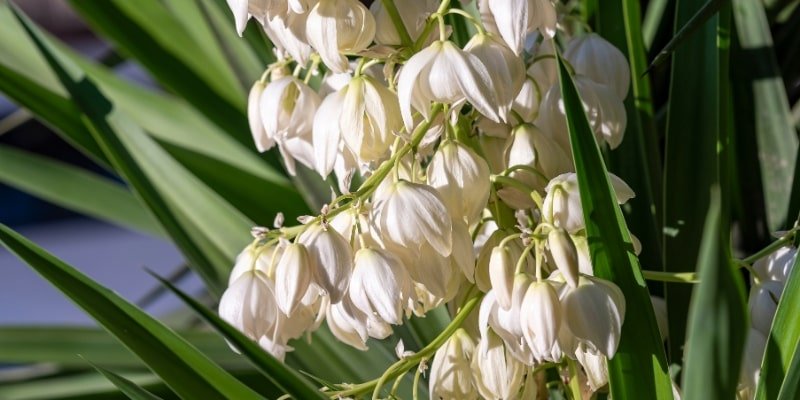
Scientific Name: Yucca elata
Plant Type: shrubs
Plant Size: 2 to 4 feet
Sun Exposure: Direct sunlight
Geographic Origin: Southern North America
Plant Zone: 4 to 11
More than forty perennial plants, shrubs, and trees belong to the genus Yucca. Some, including Yucca gigantean and Yucca aloifolia, are grown as houseplants. The Caribbean has an eye-catching appearance, resembling agave or dragon plants. However, because it takes so long, you can use it as a houseplant for many years before it takes up too much room.
The majority may be grown outside, even in temperatures as low as 10 degrees Fahrenheit. Certain types may withstand temperatures below freezing. When introducing yucca plants, pet owners should exercise caution because all of the plant’s parts are poisonous to dogs, cats, and horses.
95. Bottlebrush Buckeye
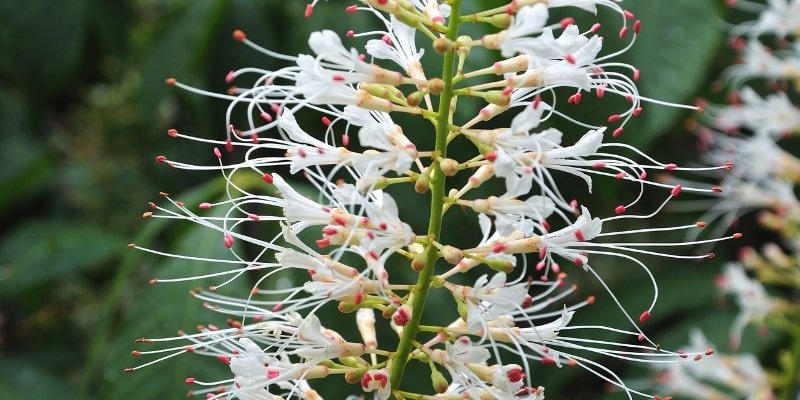
Scientific Name: Aesculus parviflora
Plant Type: Perennial, Shrub
Plant Size: 8-12 ft. tall
Sun Exposure: Sun Full, Partial, Shade
Geographic Origin: Southeastern United States
Plant Zone: 4 to 9
Early July brings spectacular long, fluffy white bloom clusters on the attractive bottlebrush buckeye shrub. It works well as a specimen plant, an understory planting in woodland gardens, or a shrub border.
The amazing dark green compound leaves with a gritty texture turn a rich buttery golden in the autumn. This is a huge shrub that should only be used in large plantings because it tends to sucker and will eventually grow twice as broad as it is high. Likewise, it is called Aesculus macrostachya.
96. Southern Magnolia

Scientific Name: Magnolia grandiflora
Plant Type: Shrub
Plant Size: 27.5 m (90 ft) in
Sun Exposure: Unfiltered Sunlight
Geographic Origin: Southeastern United States, from Virginia to central Florida, and west to East Texas
Plant Zone: 6 to 10
Southern Magnolia, also known as White Magnolia Grandiflora, is a gorgeous evergreen tree that is well-known for its glossy, dark green leaves and big, fragrant white flowers.
This famous tree, which is emblematic of the American South, gives gardens and landscapes a classic beauty. Is mostly an outdoor tree that looks great in gardens and other open areas. For it to flourish, it needs well-drained soil, full sun, or partial shade.
97. White Sweet Rocket
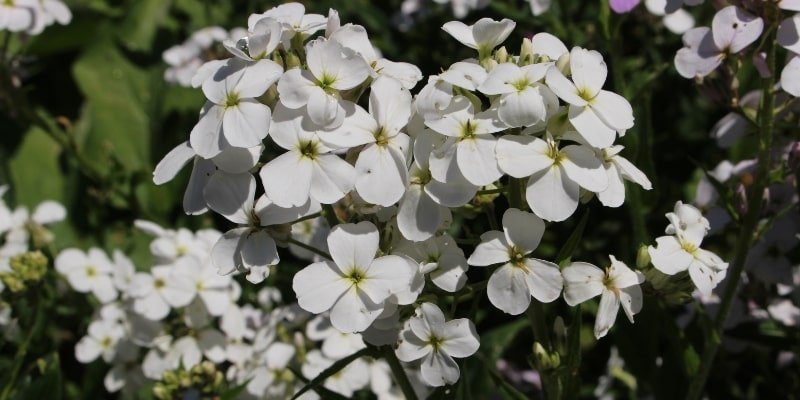
Scientific Name: Hesperis matronalis
Plant Type: Herb seeds
Plant Size: 36” tall x 18” wide
Sun Exposure: Full sun to part shade
Geographic Origin: Europe and Asia
Plant Zone: 3 to 9
Pure white blooms with a beautiful perfume are held above rosettes of dark green foliage. This biennial or short-lived perennial is ideal for naturizing in a wildlife garden because it easily self-seeds and frequently follows type.
Like all sweet rockets, it attracts a lot of bees and other beneficial insects, and in the spring and early summer, the air is fragrant with the scent of the fragrant blossoms. They look fantastic sprinkled over salads and are tasty as well. Despite its brief lifespan, it freely self-seeds.
98. Clary Sage
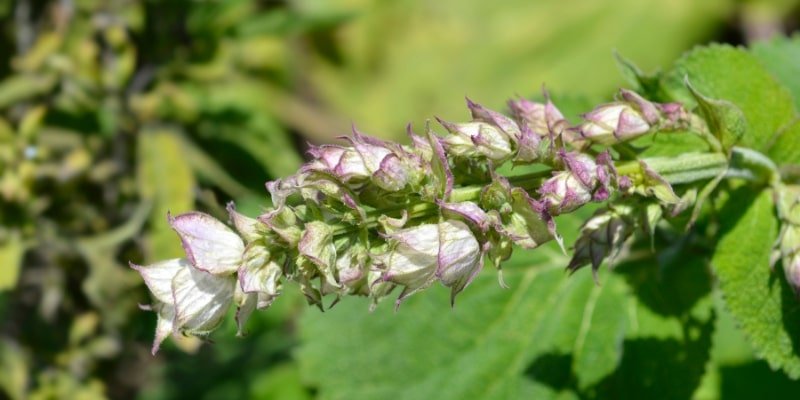
Scientific Name: Salvia sclarea
Plant Type: Herbaceous perennial
Plant Size: 2 to 5 feet tall and 2 to 3 feet wide
Sun Exposure: Full sun
Geographic Origin: Southern Europe to central Asia
Plant Zone: 5 to 9
Clary sage is an herb that can grow up to six feet tall and is either biennial or perennial. Clary sage is well-known for its skin-benefiting qualities and relaxing effects. One of the most calming balanced and relaxing essential oils is clary sage, which contains lineally acetate, an ester group constituent.
The plant known as clary sage was widely used to treat skin ailments during the middle Ages. The inhalation of clary sage facilitates a calm and peaceful sleep by encouraging sensations of relaxation.
99. Arctic Poppy

Scientific Name: Papaver radicatum
Plant Type: Herbaceous
Plant Size: 10 to 15 cm tall
Sun Exposure: Direct sunlight
Geographic Origin: Canada, Greenland, South Africa, the Contiguous United States, and Alaska
Plant Zone: 2 to 7
Despite having some very delicate yellow or white petals, Arctic poppies are strong and durable plants. By tracking the sun’s path across the sky, these flowers draw insects to the heart of their bloom as they turn in all directions towards it. In meadows, mountains, and dry riverbeds, Arctic poppies can be found growing. They grow well in the presence of stones that
Give the roots cover from the sun’s heat. A thick rosette of lance-shaped, pinate leaves grows at the base of the stem. The Arctic poppy’s overall growth rate is quite low, but its flowering stems reach a maximum length of 10 cm.
100. Hollyhocks
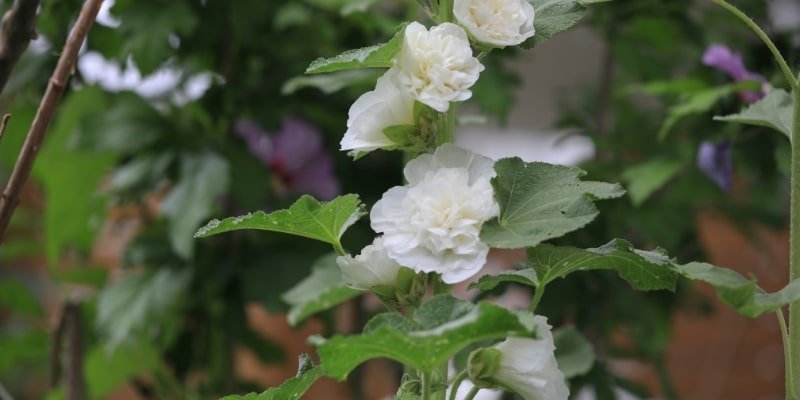
Scientific Name: Alcea
Plant Type: Perennial
Plant Size: 6-8 feet tall, 1-2 feet wide
Sun Exposure: Direct sunlight
Geographic Origin: China
Plant Zone: 3 to 8
Hollyhocks (Alcea rosea), a traditional cottage garden mainstay, produce a large number of flowers on tall stalks in the middle of July. Many of the most popular types are biannual, which means that they take two years to complete their life cycle. The first year is devoted to accumulating energy and growing foliage.
The stalks erupt, flowers bloom, and seeds begin to grow in the second year. Many types, on the other hand, have characteristics of short-lived perennials and, if planted early enough in the spring or started indoors in the winter, will flower in their first year.
101. Wallflower
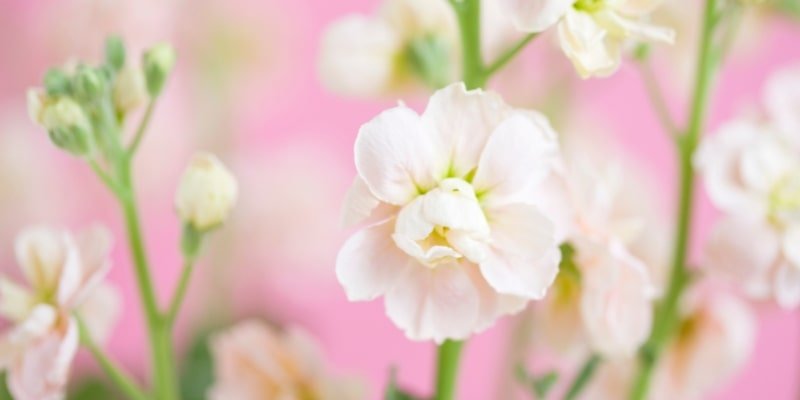
Scientific Name: Erysimum
Plant Type: Annuals, herbaceous perennials or sub-shrubs
Plant Size: Height, 1 to 3 feet; Width, 1 to 2 feet.
Sun Exposure: Full Sun
Geographic Origin: Southern Europe
Plant Zone: 3 to 10
A low-growing, mounding herbaceous perennial or biennial, wallflowers have stunning, long-blooming flowers. They are produced as a cool-season annual in the southern states. They are frequently considered biennials and have brief lifespans. The hybrids were bred for longer bloom times and come in a variety of colours. The striking blooms appear in groups of pink, orange, yellow, or red throughout the summer.
Plant in full sun in soil that is ordinary to sandy. Once planted, it can withstand drought and is resistant to deer. Used in pots, along pathways, in front of borders, and in rock gardens.
102. Star of Bethlehem
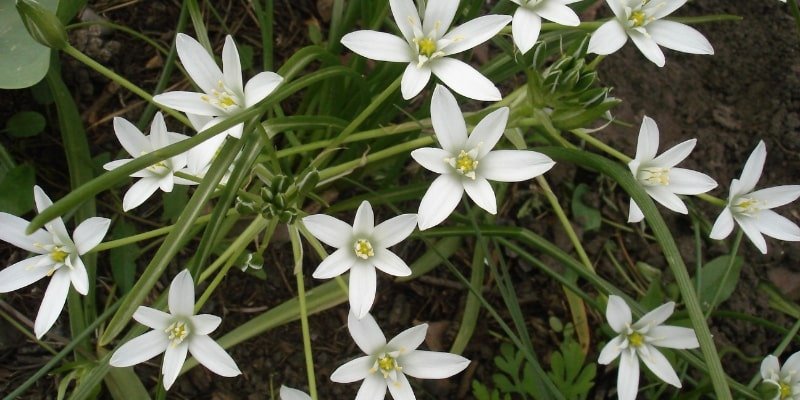
Scientific Name: Ornithogalum umbellatum
Plant Type: Perennial bulbous
Plant Size: 19 inches tall
Sun Exposure: Direct Sunlight
Geographic Origin: Babylonia or Persia
Plant Zone: 7 to 11
The star of Bethlehem is a perennial bulb that blooms. It grows in bunches and sends up flower stalks that resemble little stars. The blooms bloom in the late morning and wither away in the evening or on overcast days.
Bulbs of the Star of Bethlehem thrive best in mild climates with full to partial sun and well-draining soil. In fact, these bulbs can become invasive because of how quickly they develop.
103. Thyme

Scientific Name: Thymus vulgaris
Plant Type: Perennial
Plant Size: 6-12 in. tall
Sun Exposure: Full Sun
Geographic Origin: Southern Europe from Spain to Italy
Plant Zone: 5 to 9
Thymus vulgaris belongs to the Lamiaceae family of mints. It is a short, bushy shrub that grows everywhere on the globe. Common names for Thymus vulgaris include “thyme.”
A common spice to enhance the flavour of meals is thyme. It is also occasionally used as an essential oil or as a dietary supplement in the form of capsules. In addition to adding flavour to meals, thyme is thought to provide therapeutic benefits.
According to research, it may contain antioxidant, antibacterial, anti-inflammatory, and other properties that make it helpful in the treatment of a number of illnesses.
104. White Buttercup
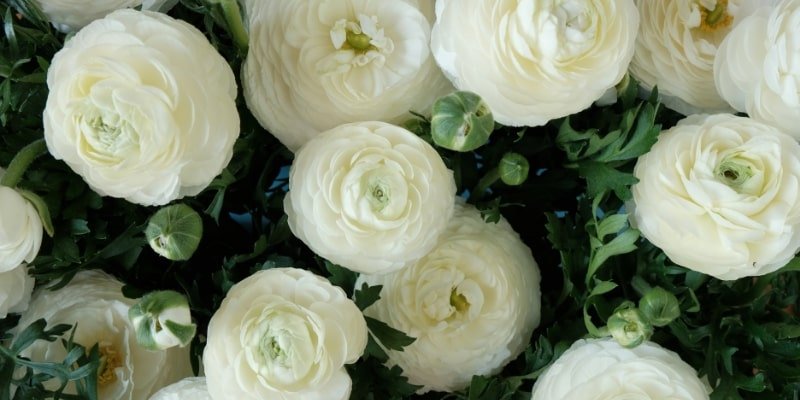
Scientific Name: Turnera subulata
Plant Type: Herbaceous
Plant Size: 2 ft
Sun Exposure: Direct Sunlight
Geographic Origin: Eurasia
Plant Zone: 8 to 11
One of the most exquisite garden flowers are white buttercups, which have creamy white petals that turn yellow at the base and distinctive black patterns that serve as nectar cues. In warm, tropical temperatures, these plants bloom profusely in the spring and summer and virtually all year round.
The lower surface of leaves may or may not be covered in tiny white hairs. Sunken veins and a somewhat elevated leaf surface characterize the highly noticeable veining. With branching stems that sag to the ground as they grow longer, white buttercup plants have the ability to cover a wide area. When given enough water and sunlight, they blossom freely, covering the plant in stunning, vivid flowers with five rounded, cream-coloured petals.
105. Shrubby bindweed
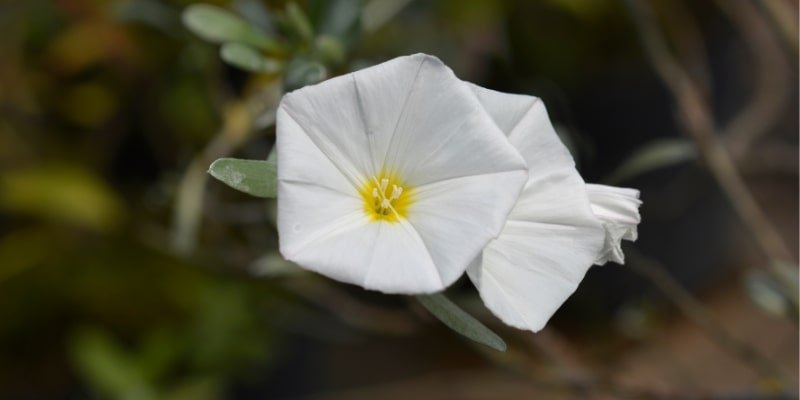
Scientific Name: Convolvulus cneorum
Plant Type: Evergreen shrub
Plant Size: 2 ft. tall (60 cm)
Sun Exposure: Full Sun
Geographic Origin: Europe and Asia
Plant Zone: 3 to 10
The most well-known common names for Convolvulus cneorum are silvery bindweed and shrubby bindweed. It is a very lovely, low-growing evergreen shrub that spreads into the shape of a flattened mound. Tiny, delicate pink buds open into funnel-shaped white blooms throughout the spring and summer. These flowers open in the morning and close in the evening, just like other plants of the morning glory kind.
Convolvulus cneorum is known for its stunning flowers and pink buds, but its lustrous, silvery leaves are even more striking. Contrary to certain plants, convolvulus cneorum boasts shimmering leaves that give it a real metallic silver colour. Convolvulus cneorum is a wonderful addition to any garden because of its understated elegance.
106. Black-Eyed Susan
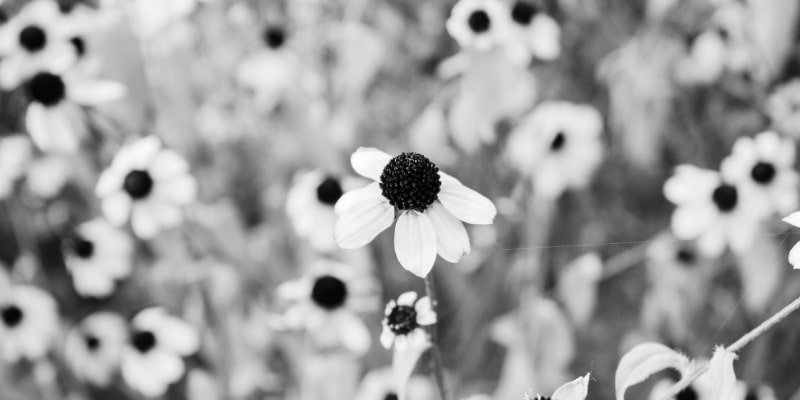
Scientific Name: Rudbeckia hirta
Plant Type: Perennial
Plant Size: 24 to 36 inch
Sun Exposure: Full Sun
Geographic Origin: Eastern and Central North America
Plant Zone: 3 to 10
Reliable and low-maintenance A mainstay in gardens nowadays are black-eyed Susan’s (Rudbeckia hirta). Over broad, rough-textured, ovate green leaves, daisy-like rays of bright yellow petals and dark centre discs rise. Grows throughout the Midwest along roadside ditches and in natural environments. It is an excellent option for large wildflower gardens due to its capacity to self-seed.
Once the spring frost has passed, you can plant it. It takes two to three years to reach full height, although it will flower in its first summer. Its huge seed heads resembling daisies in bloom. Not to mention, it possesses genus-specific, hairy, scratchy leaves.
107. Chinese Forget Me Not ‘White’
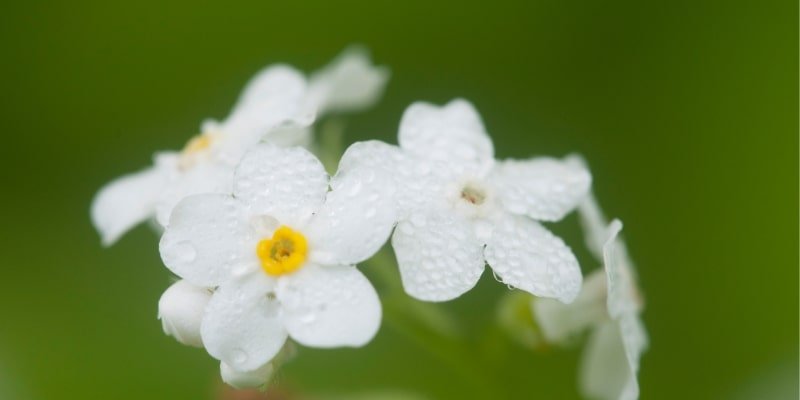
Scientific Name: Cynoglossum amabile
Plant Type: Annual, Biennial
Plant Size: 1-2 ft. tall, 8-12 in. wide
Sun Exposure: Sun Full, Partial
Geographic Origin: China and Bhutan
Plant Zone: 6 to 9
The flowering plant known as Chinese forget-me-not (Cynoglossum amabile) is planted as a hardy annual or biennial for its eye-catching sprays of small blue, pink, or white blossoms. Because it blooms the year it is planted, unlike forest forget-me-nots (Myosotis sylvatica), this plant is a favourite among flower growers and gardeners.
Perfect for cutting gardens and bouquets. Chinese forget-me-not thrives best in full to partial light with minimal watering, planted a few weeks before your region’s last frost date. Both humans and horses should avoid this plant.
108. Dusty Miller
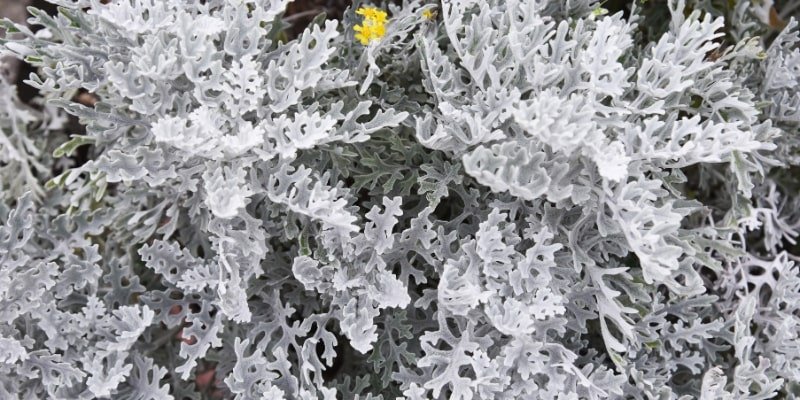
Scientific Name: Jacobaea maritima
Plant Type: Tender perennial
Plant Size: 2 feet tall
Sun Exposure: Sun Full
Geographic Origin: Mediterranean
Plant Zone: 7 to 10
Dusty miller is a durable and easily grown plant. This plant does well in both the ground and a container and appears to flourish in nearly any environment. It is grown as an annual otherwise.
Dusty Miller is a superb bedding plant that looks good in any mix of plants because of its distinctive silver leaf. It’s also great filler for setups with cut flowers. Numerous small white hairs, which are particularly noticeable on the undersides of the leaves and the stems, give the leaves their silvery appearance. Dusty miller is a bedding plant that requires little care.
109. Superbena Wipeout
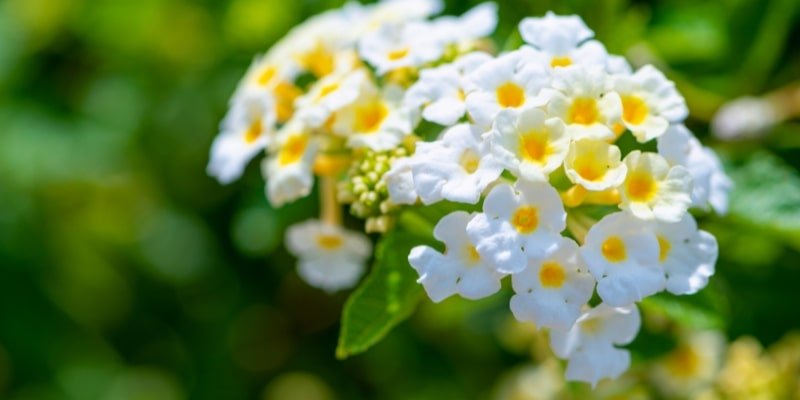
Scientific Name: Verbena speciosa
Plant Type: Annual
Plant Size: 6-12 inches tall
Sun Exposure: Full Sun
Geographic Origin: Americas and Asia
Plant Zone: 8 to 11
Verbenas are long-blooming annual or perennial flowers with an exceptionally extended bloom season and heat tolerance. Although many perennial verbenas have a limited lifespan, their vigorous growth and profuse flowering more than make up for it.
Since they flower early in the first season after planting, they also thrive well as annual flowering plants. While most perennial or vegetative propagated verbenas are well suited to growing in the heat and humidity of South Carolina, bedding-type annual verbenas started from seed do not do well in hot, humid regions.
110. White-Flowered Honesty
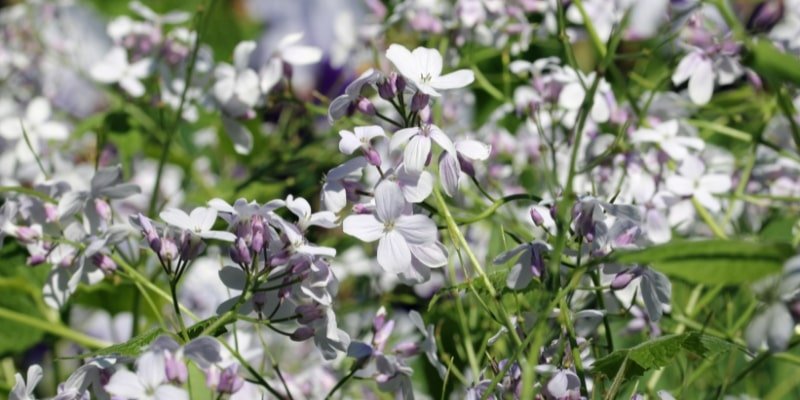
Scientific Name: Lunaria annua
Plant Type: Annual or biennial
Plant Size: 90cm tall
Sun Exposure: Full Sun
Geographic Origin: Balkans and south west Asia
Plant Zone: 5 to 9
The four-petaled flower heads of Honesty bloom in a variety of hues, ranging from deep purple to white, from mid-spring to early summer of the following year. The variety of honesty plant planted determines the colour of the flowers it produces. A few species produce white blooms instead of the deep purple or other purple-tinted flowers produced by most cultivars.
Coin-shaped, translucent seed pods emerge in the summertime to replace the early summer’s faded honesty’s flowers. When the seed pods dry, their original green colour changes to a golden brown hue. The dried flowers and seed pods are believed to last for a long time and can be used in floral arrangements.
111. Catherine’s Wheels
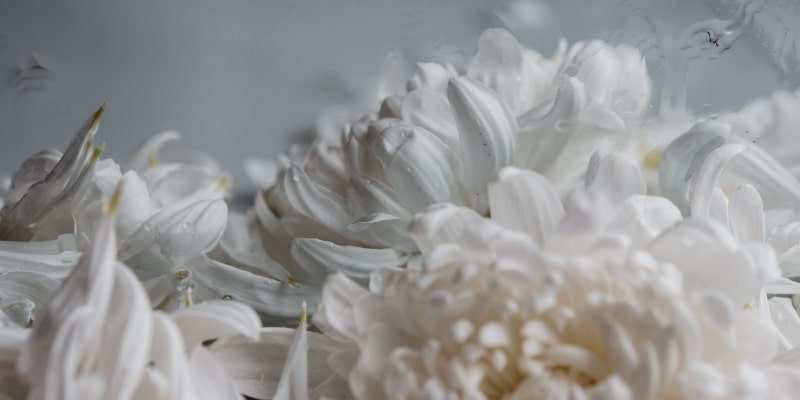
Scientific Name: Leucospermum catherinae
Plant Type: Perennial
Plant Size: 2ft tall
Sun Exposure: Full Sun
Geographic Origin: Southern Africa
Plant Zone: 7 to 9
The large, erect, evergreen shrub Leucospermum catherinae, belonging to the Proteaceae family, can grow up to 4 meters in height. Its leaves are inverted lance-shaped, hairless, and measure 9–13 cm long by 1-2½ cm wide. They have a prominent stem and three or four deep, blunt teeth that are blunt towards the tip. With age, the flower heads take on a disc form and have a diameter of roughly 15 cm, with pale orange blooms inside.
The entire head has the appearance of a spinning pincushion due to the long, initially orange, subsequently coppery bronze style that emerges from the centre of each flower and has a thicker magenta tip that is bent clockwise. In Afrikaans, its called waterluisie, while in English, it’s called wheel flower or Catherine-wheel pincushion. From September through December, flowers are in season.
White Flowers FAQs:
Q.1 which white flower is the rarest?
A. The main reason the Dutchman’s pipe Cactus is regarded as one of the rarest white flowers is that it blooms infrequently. When it does, it’s only at night, and the blossoms vanish before daybreak.
Q.2 which white flower has the finest scent?
A. The most fragrant white flowers are Lily of the Valley, Jasmine, Sweet Alyssum, Honeysuckle, Mock Orange, Freesia, Clematis, Plumeria, and Lilac.
Q.3 which white flower is the most beautiful?
A. Even if one’s definition of beauty may vary, some of the most exquisite white flowers are Christmas roses, moonflowers, larkspurs, dahlias, peonies, cosms, clematis, and ranunculus.
Conclusion
These are some of the most exquisite white flowers, though there are countless others to select from. White is one of the most common flower colours in most home gardens, but you can grow a wide variety of flowers, from annuals to perennials.
There is something for almost every grower, regardless of whether you have chosen roses or dahlias. This season, explore with these white blooms in your garden, and don’t forget to take your hardiness zone into consideration!

